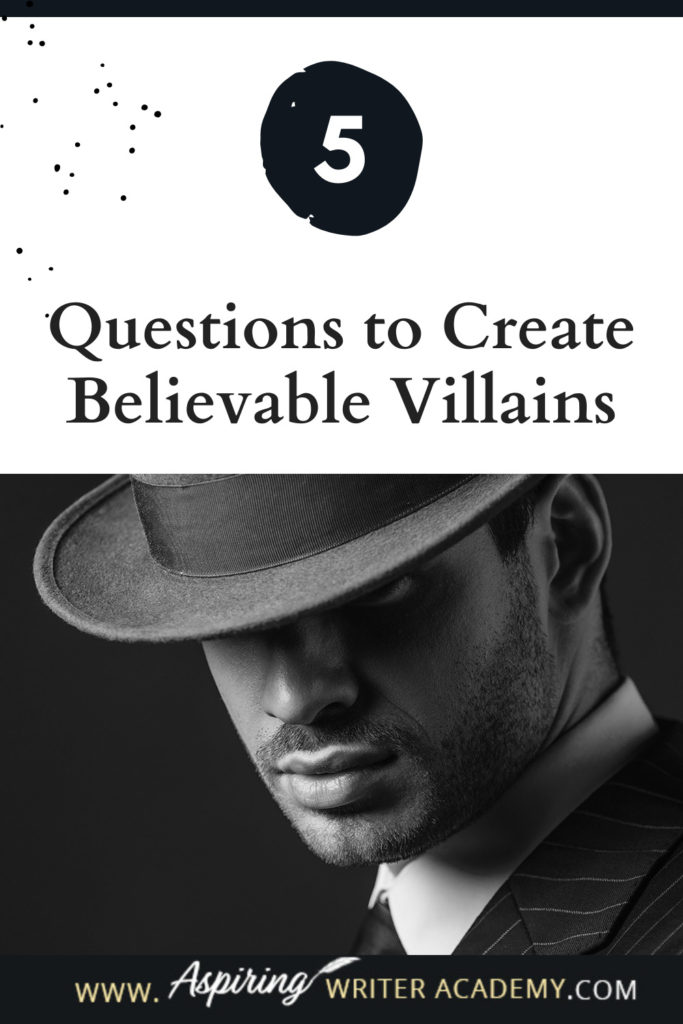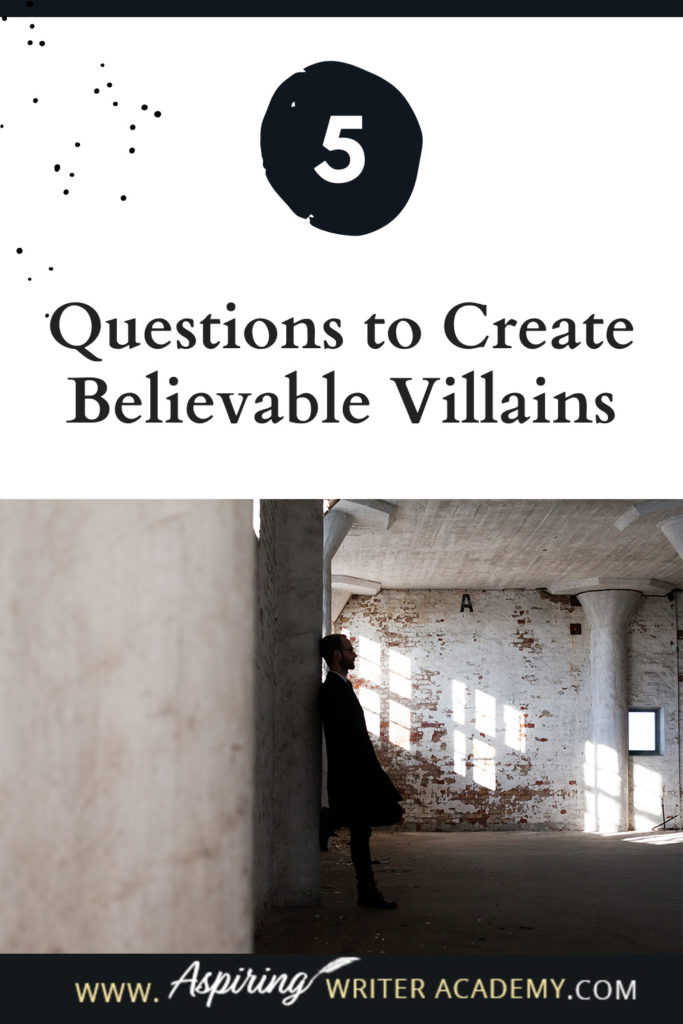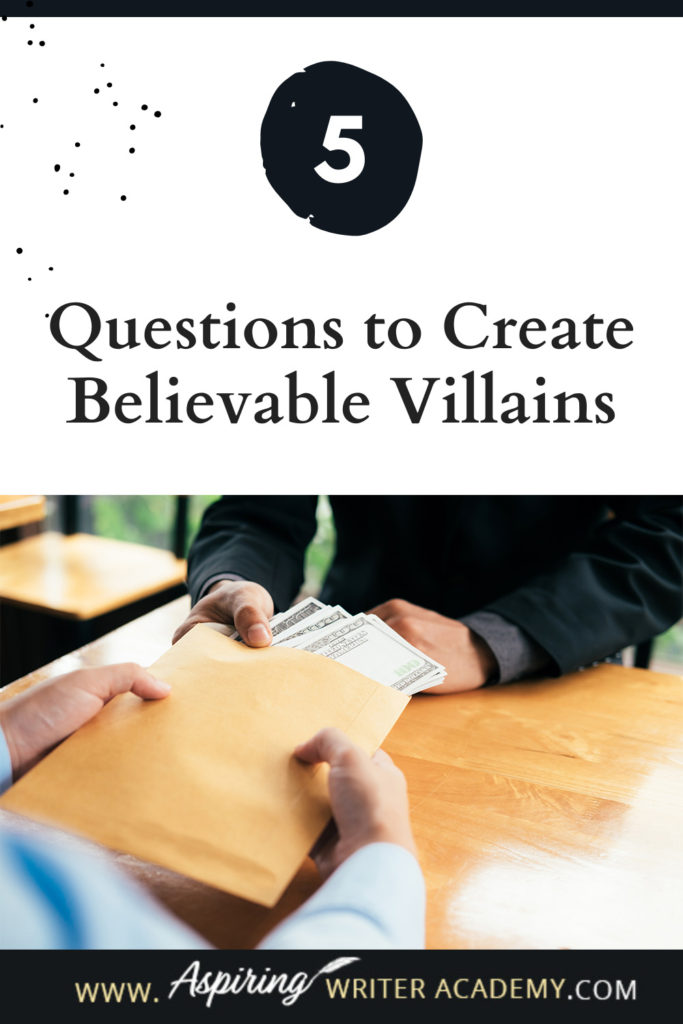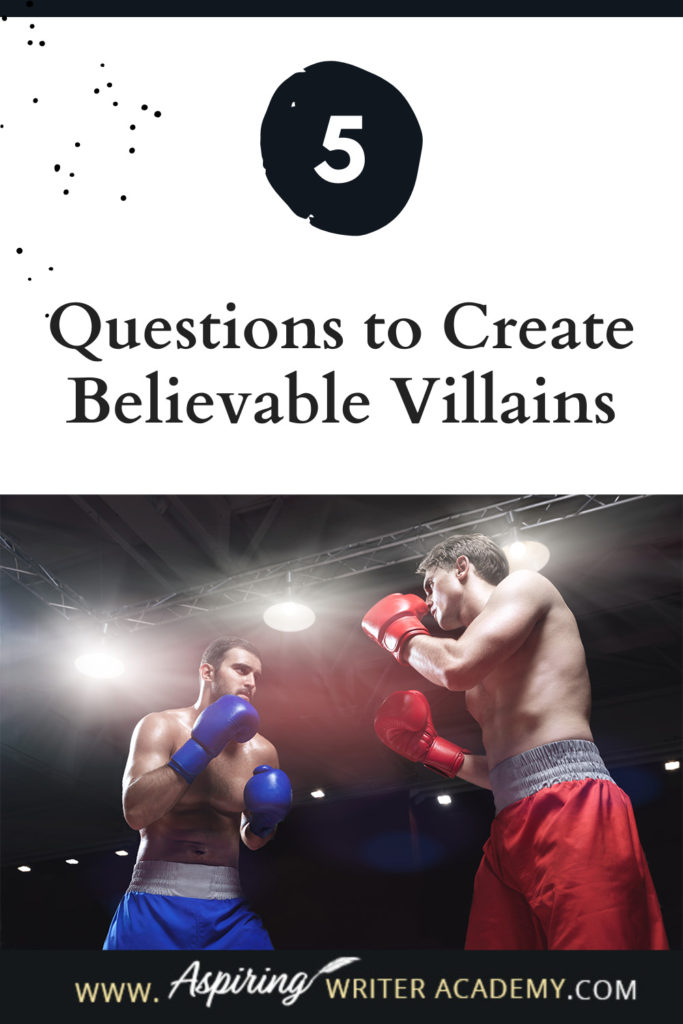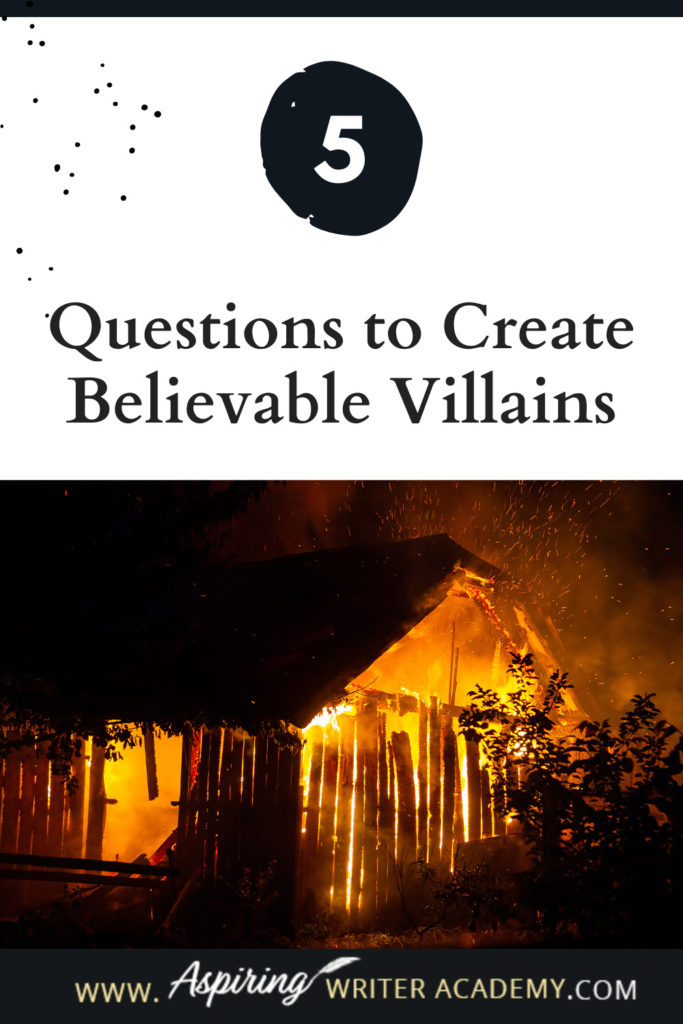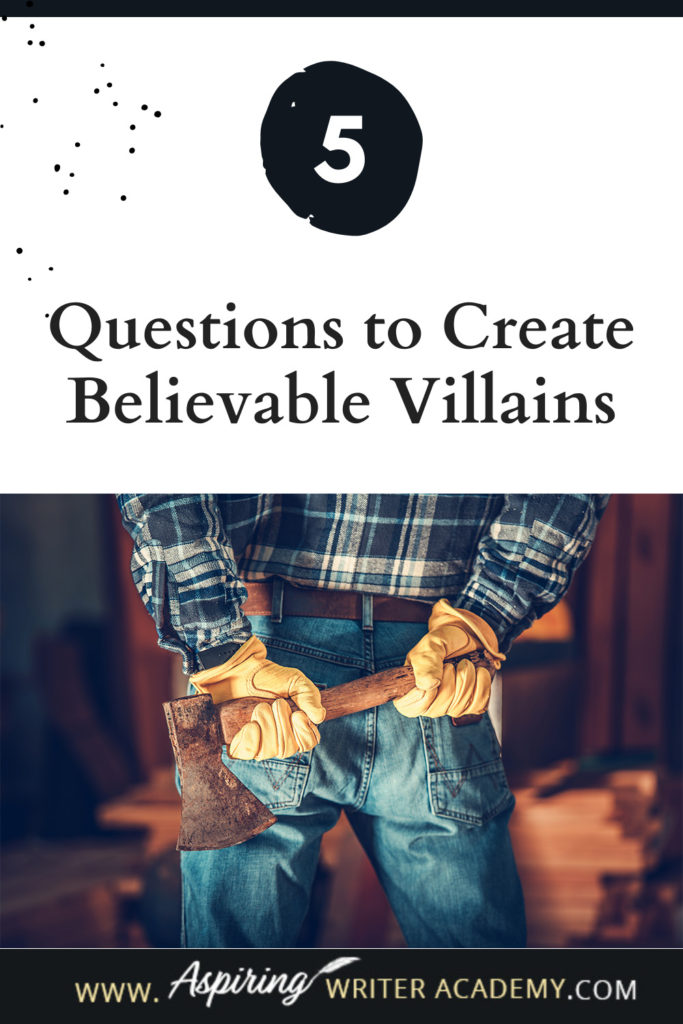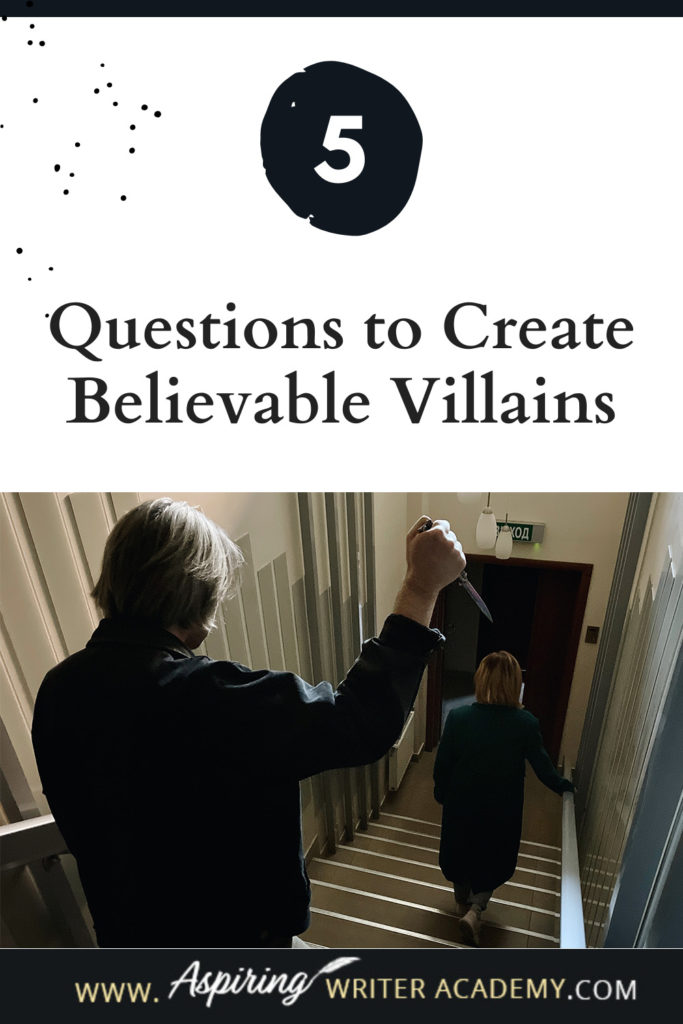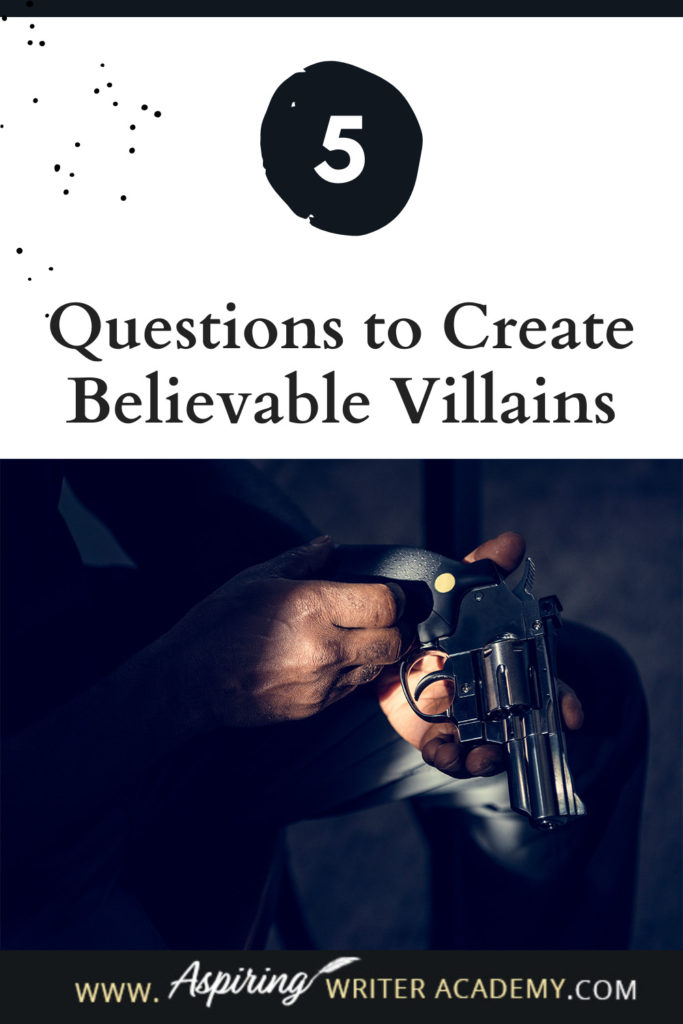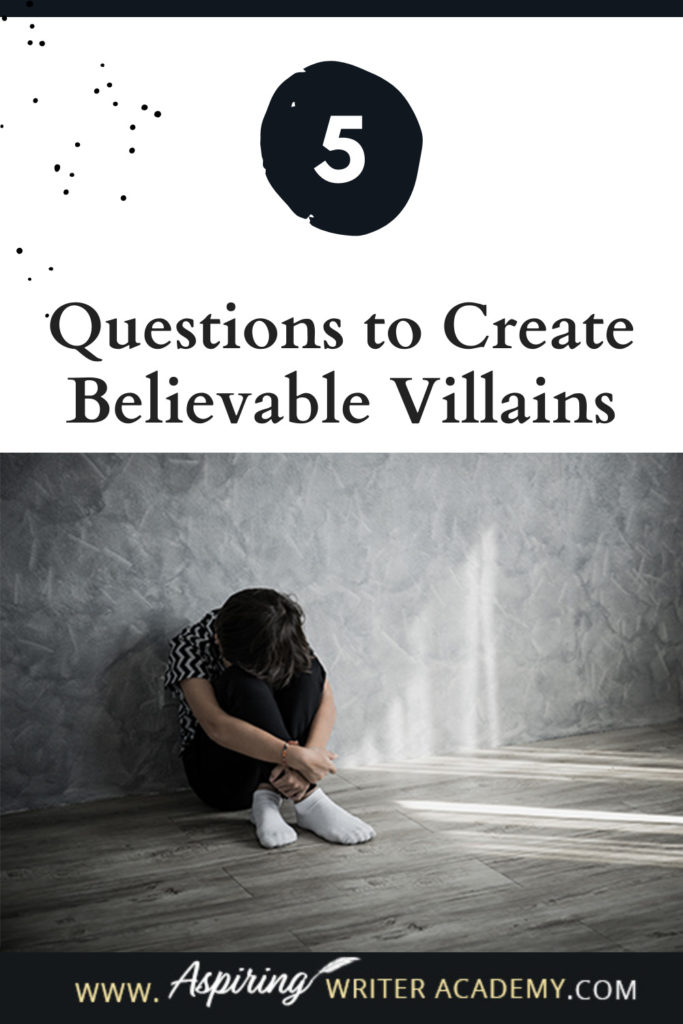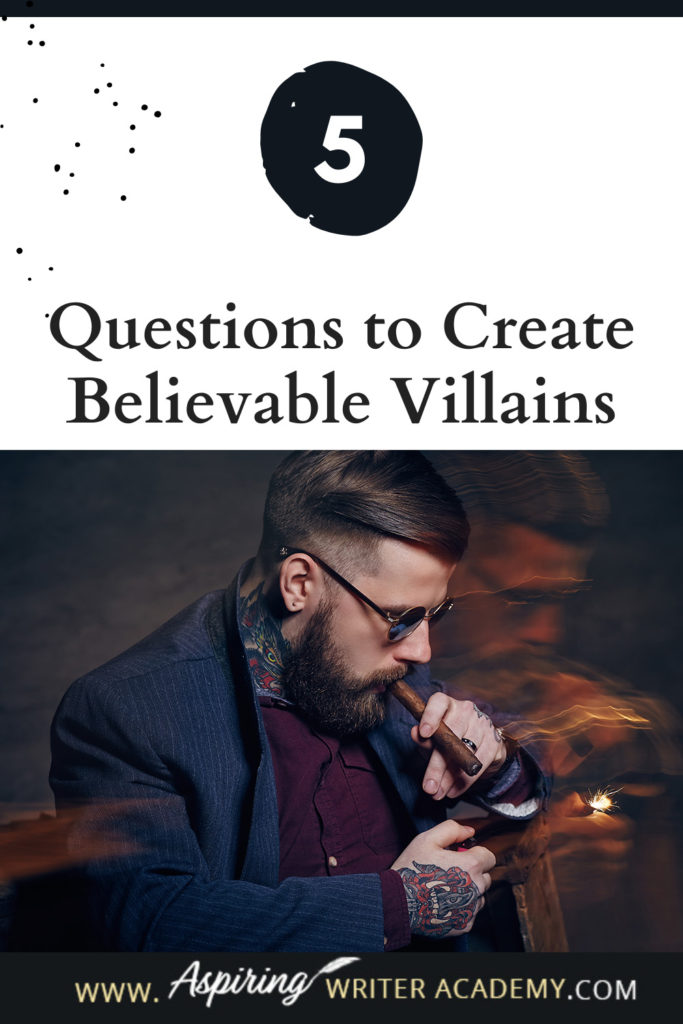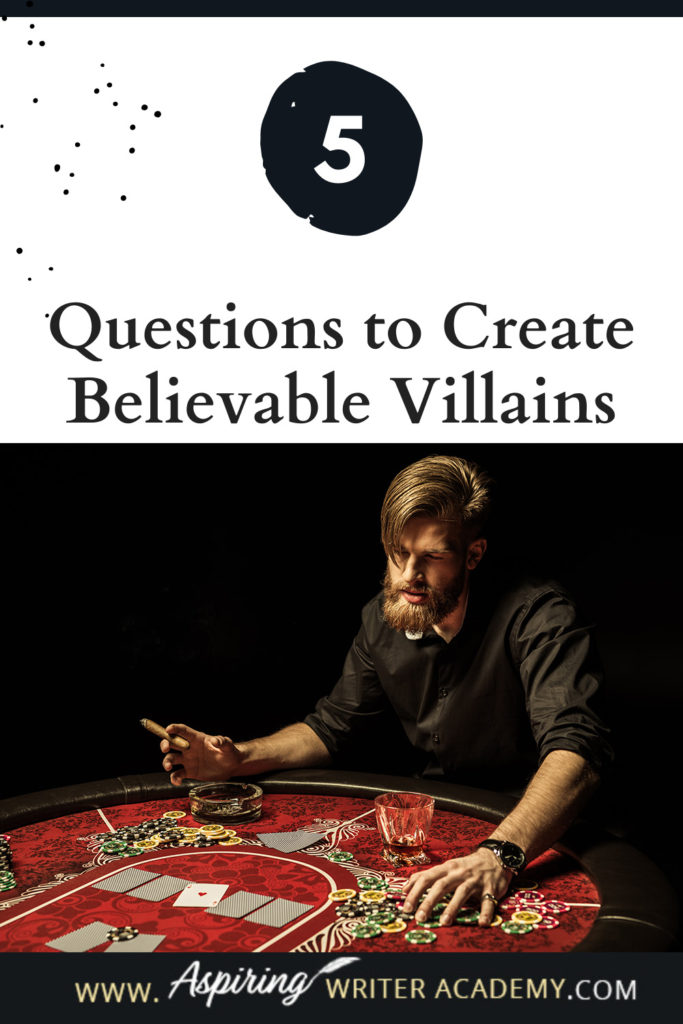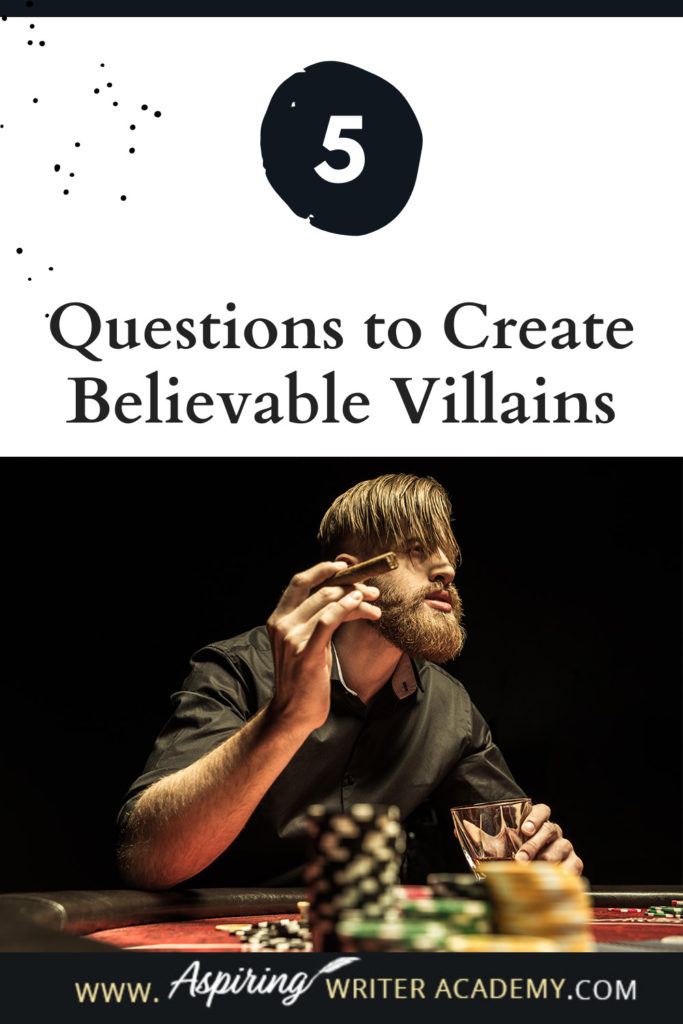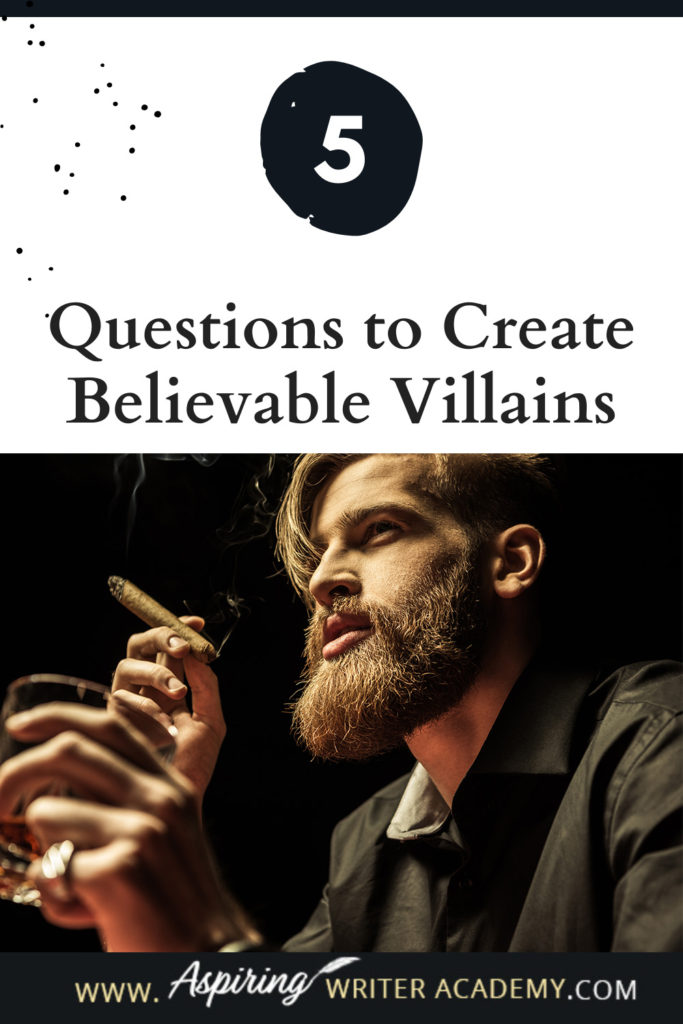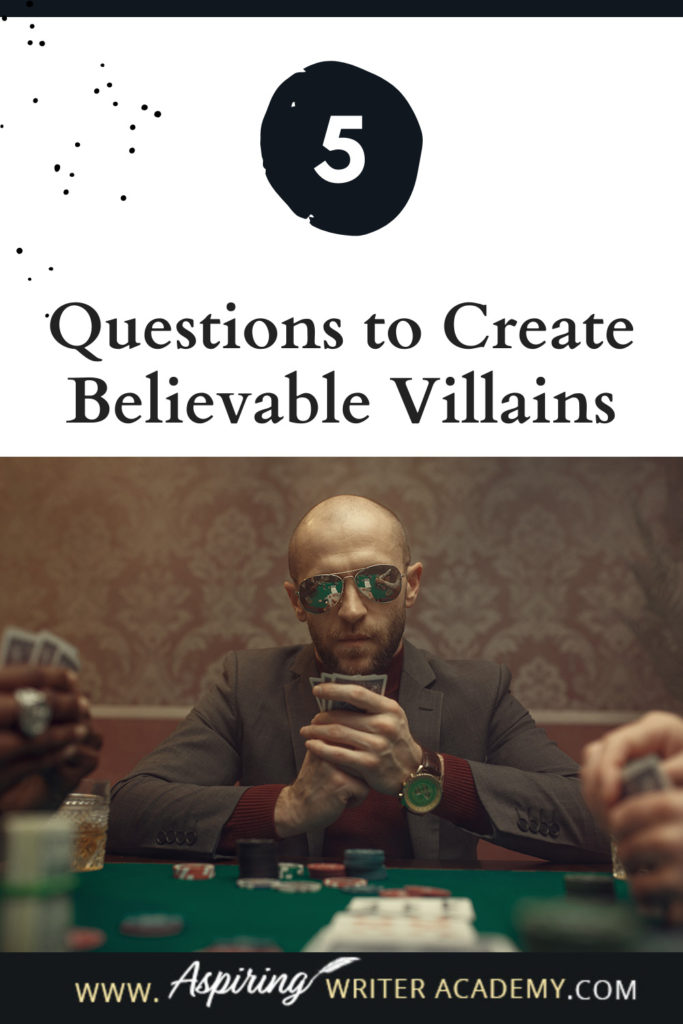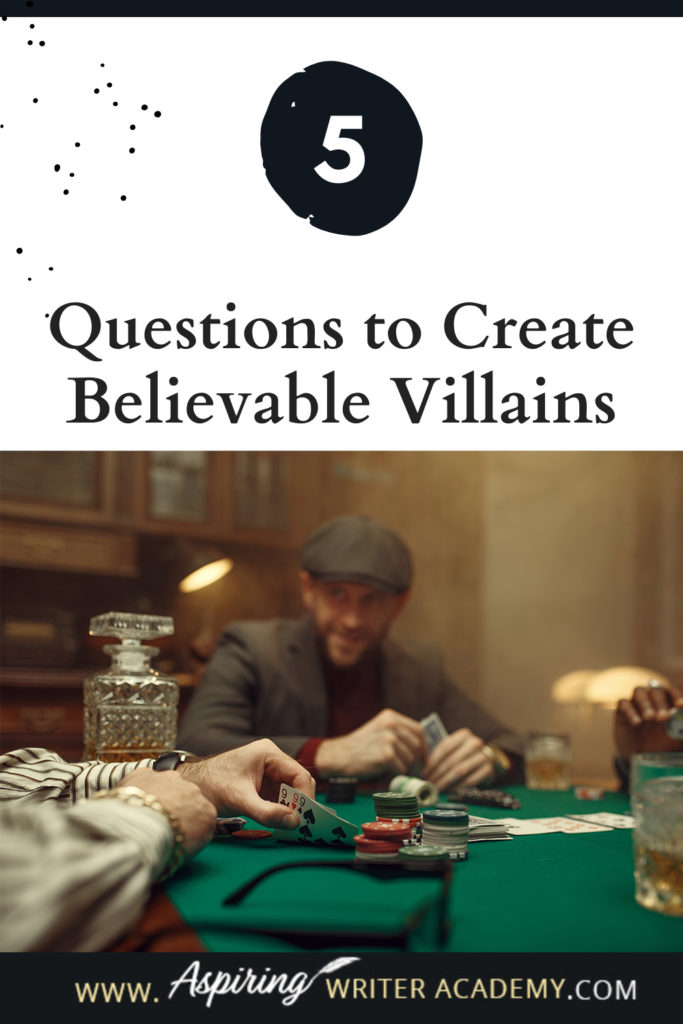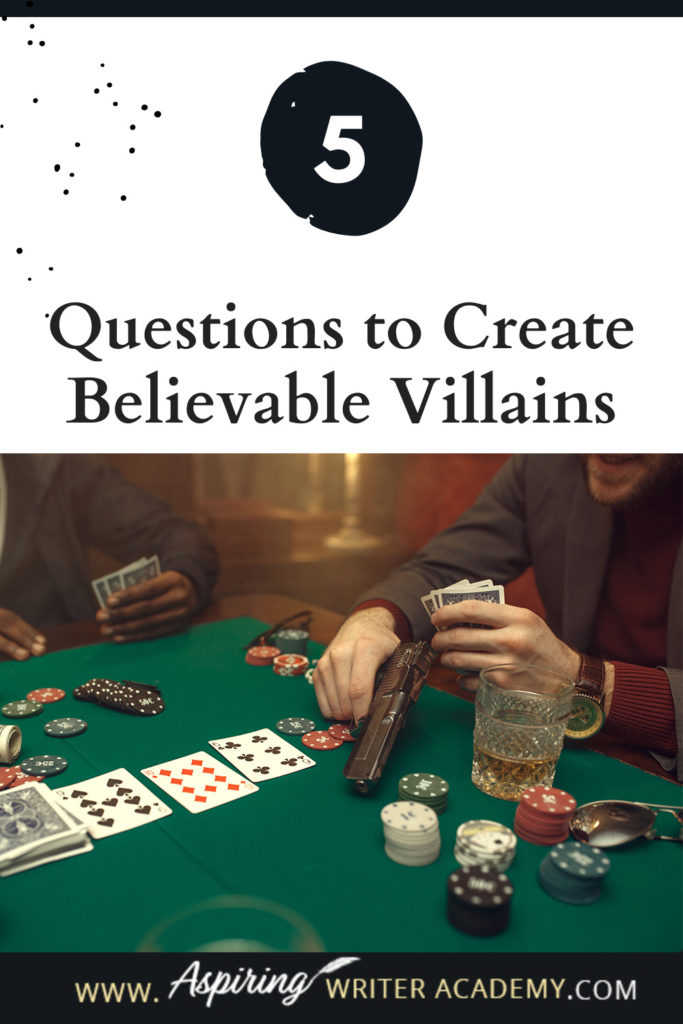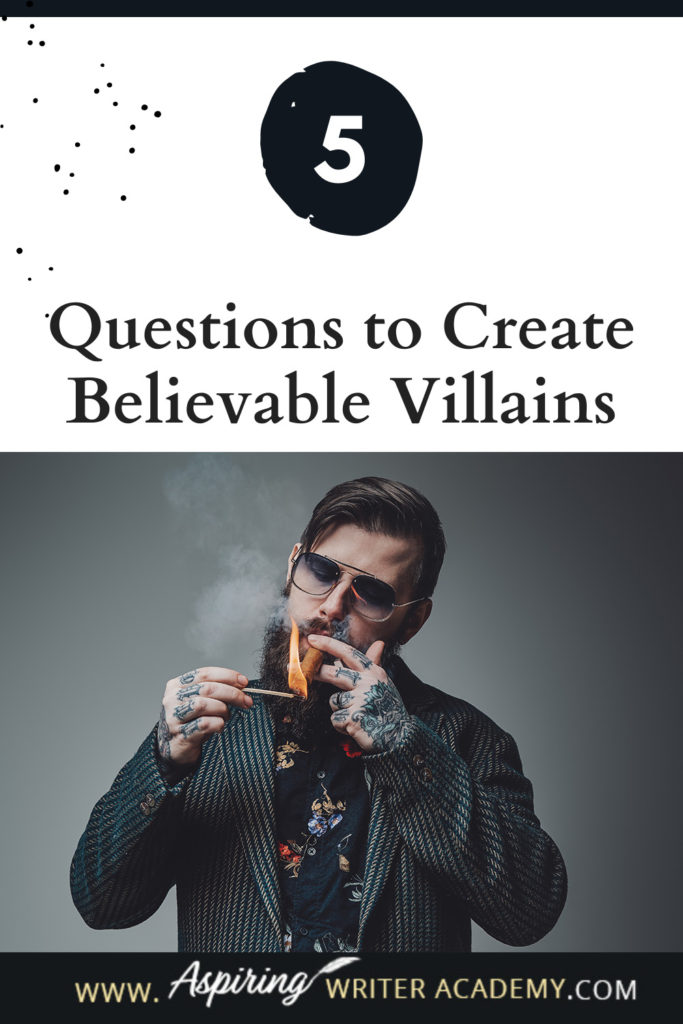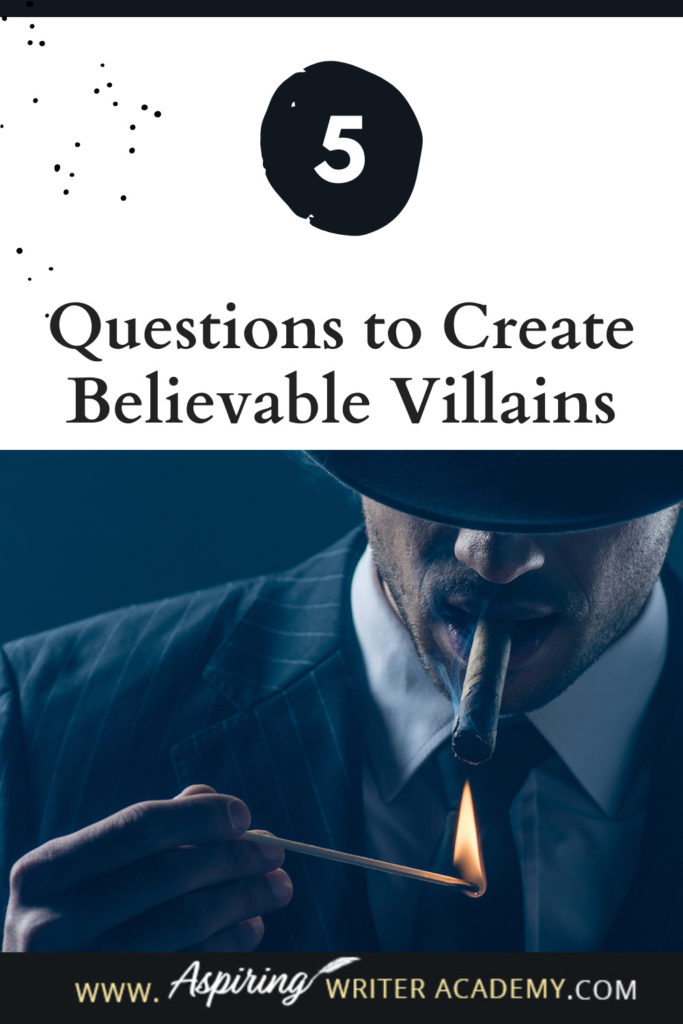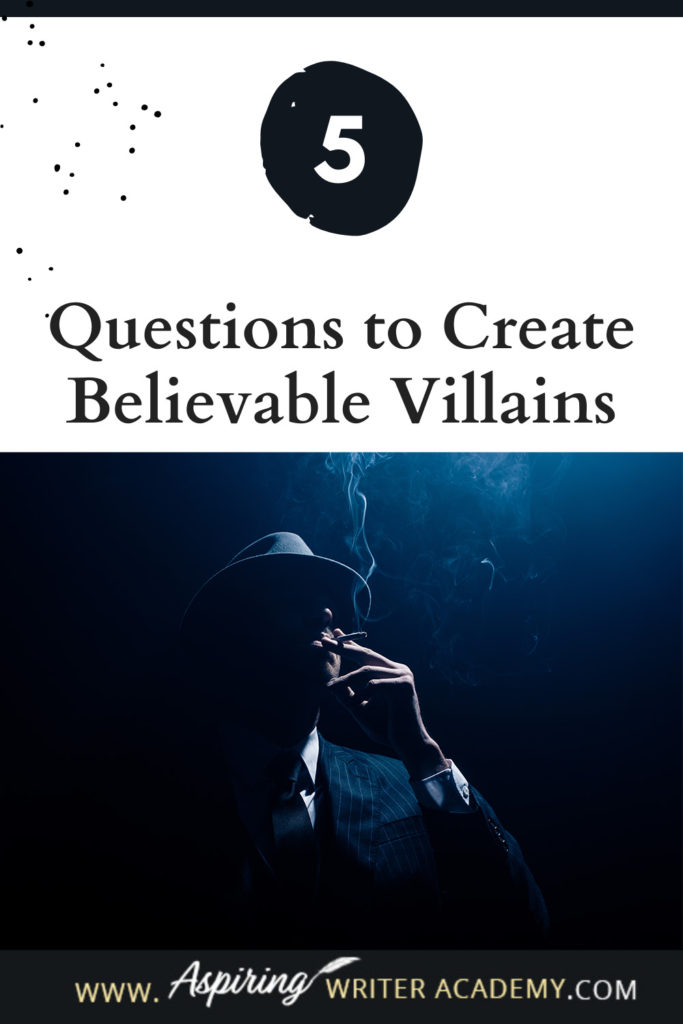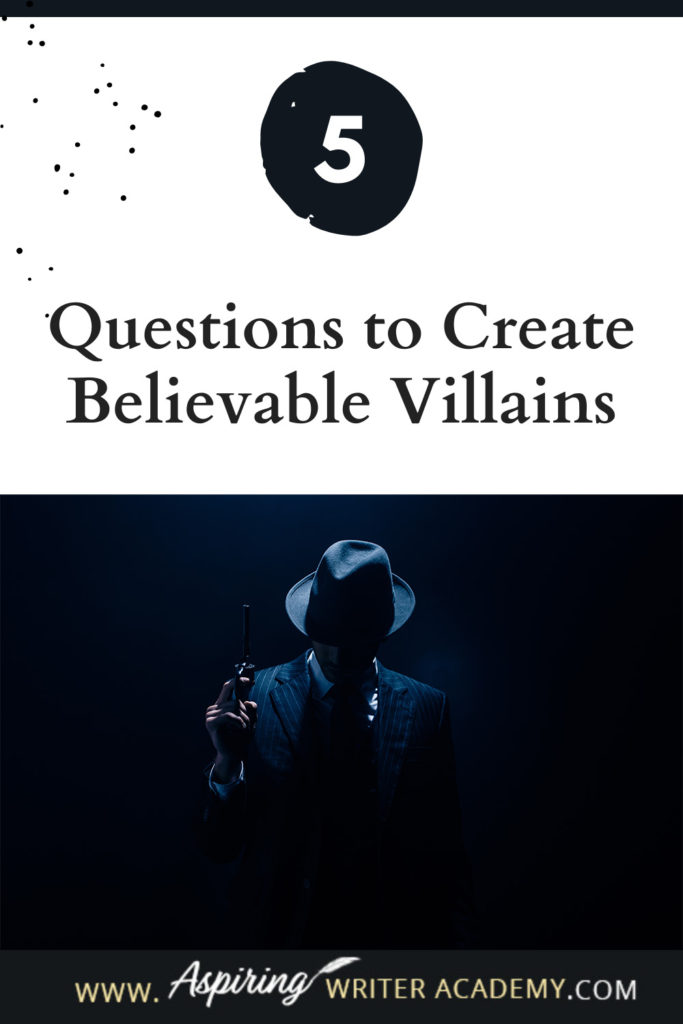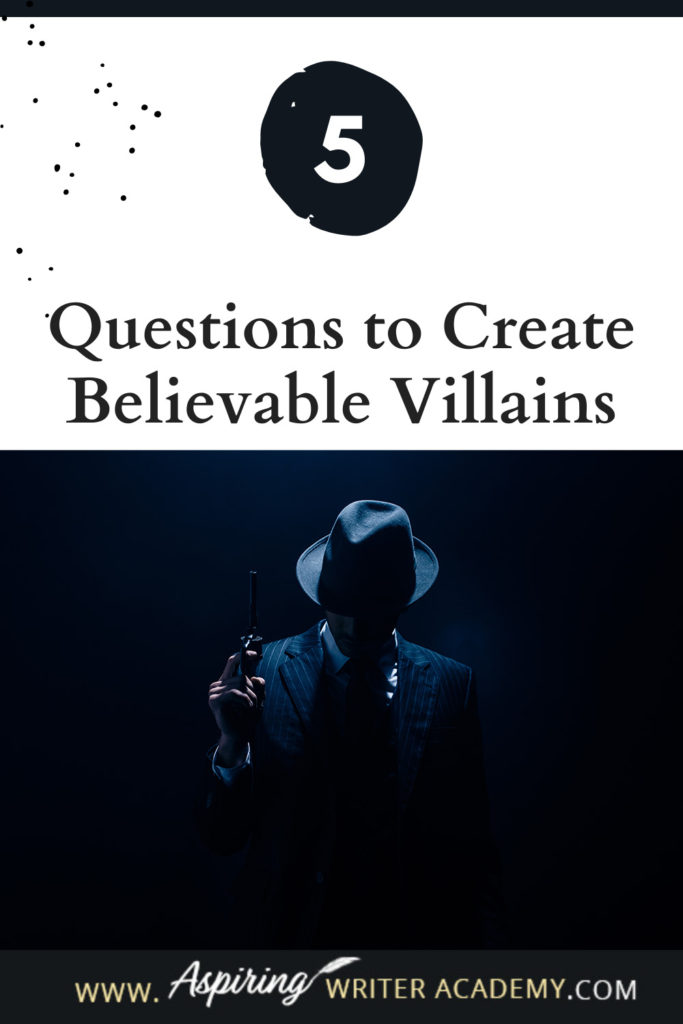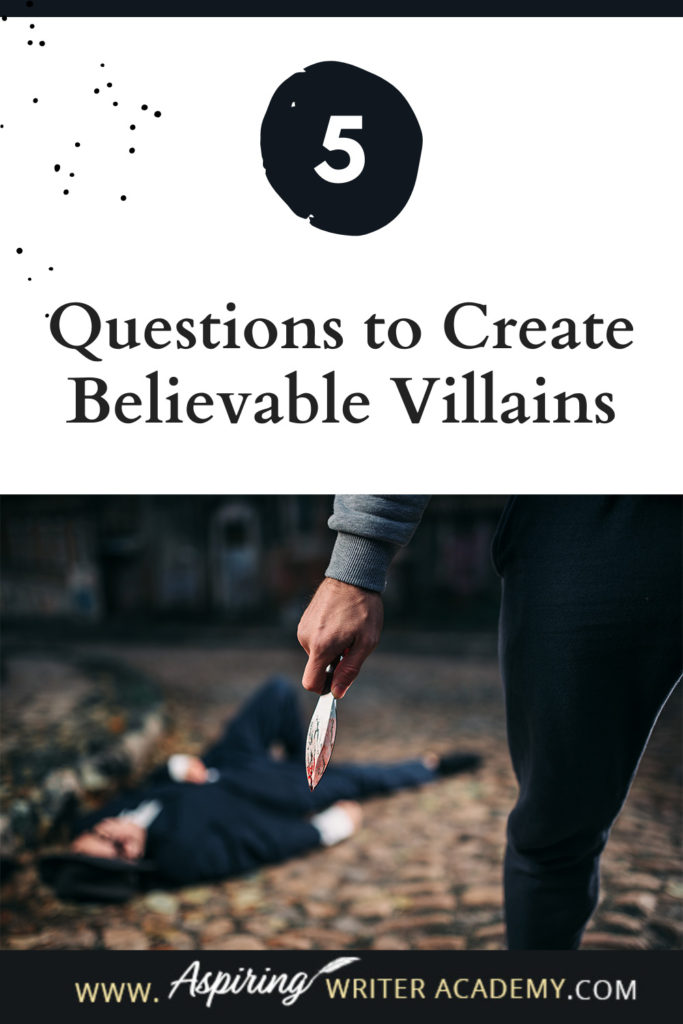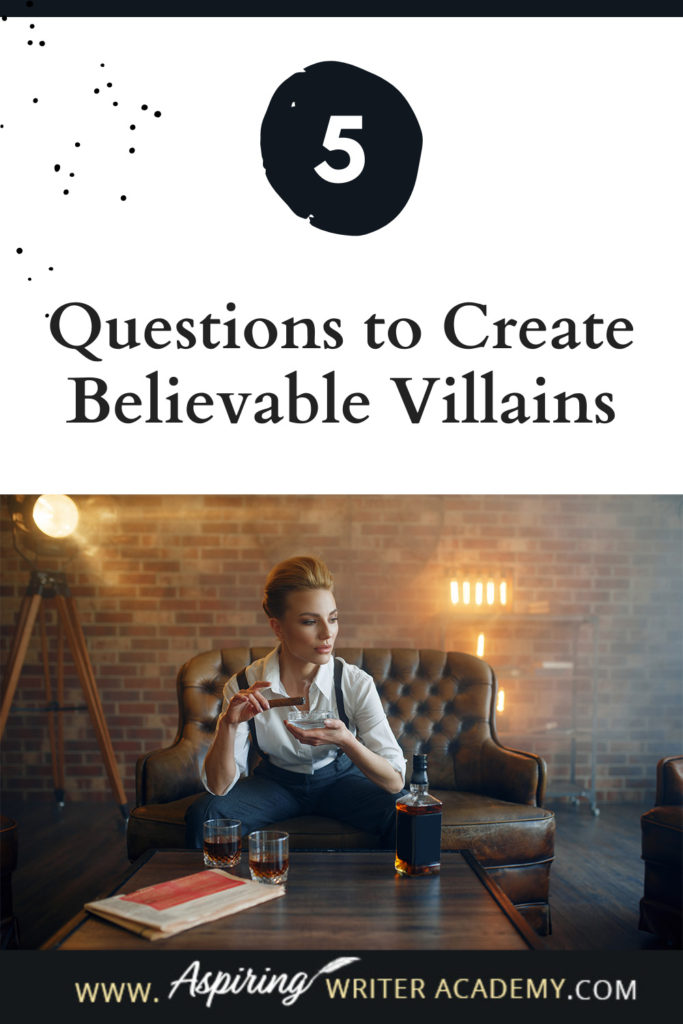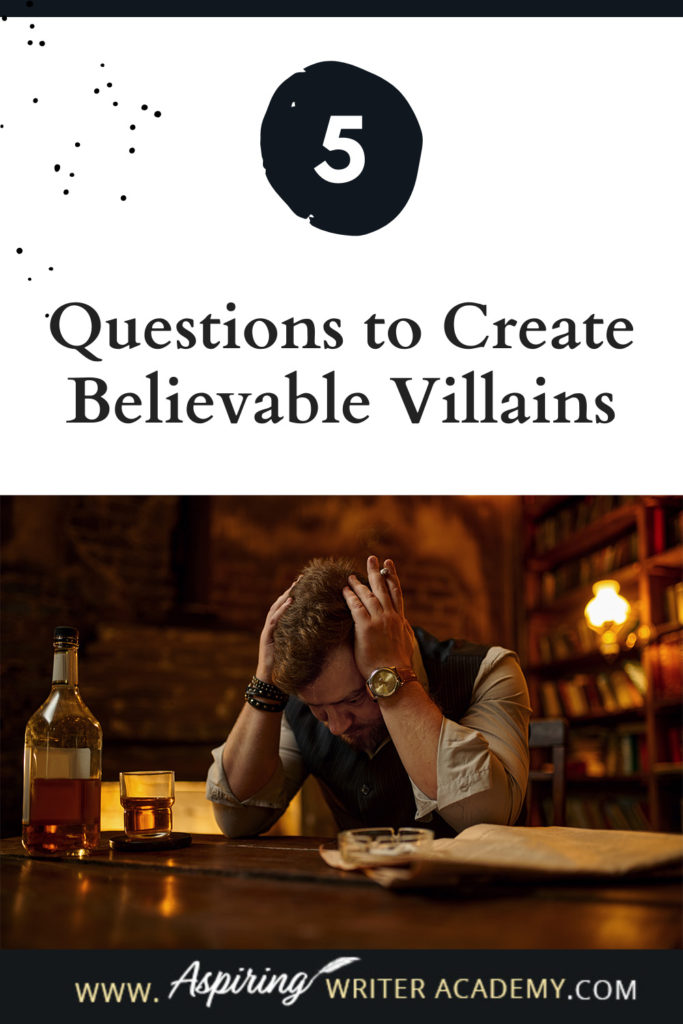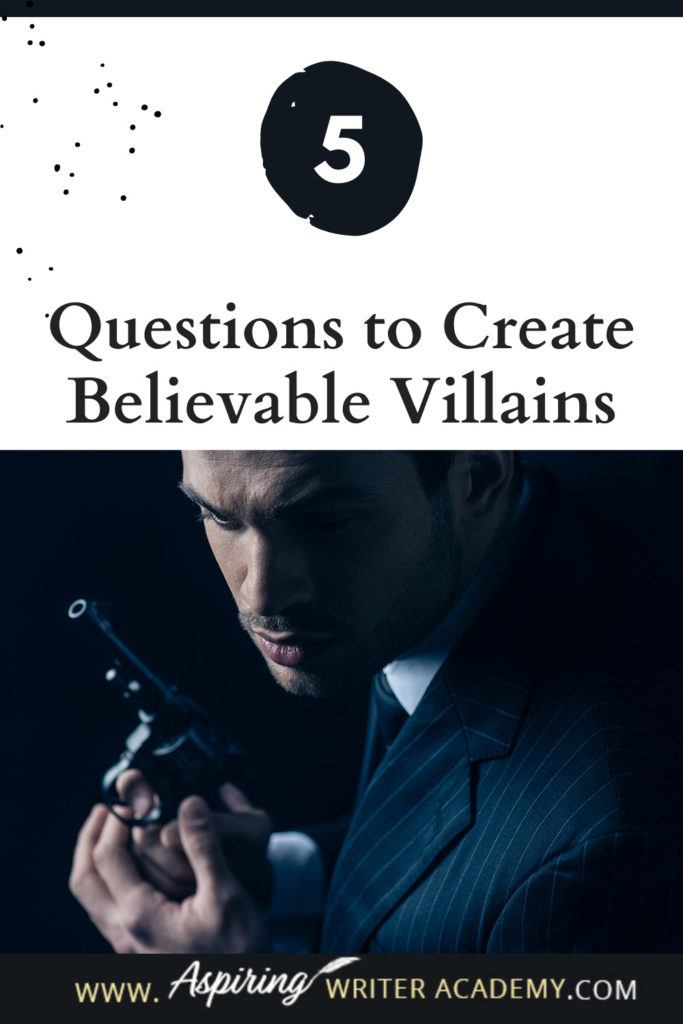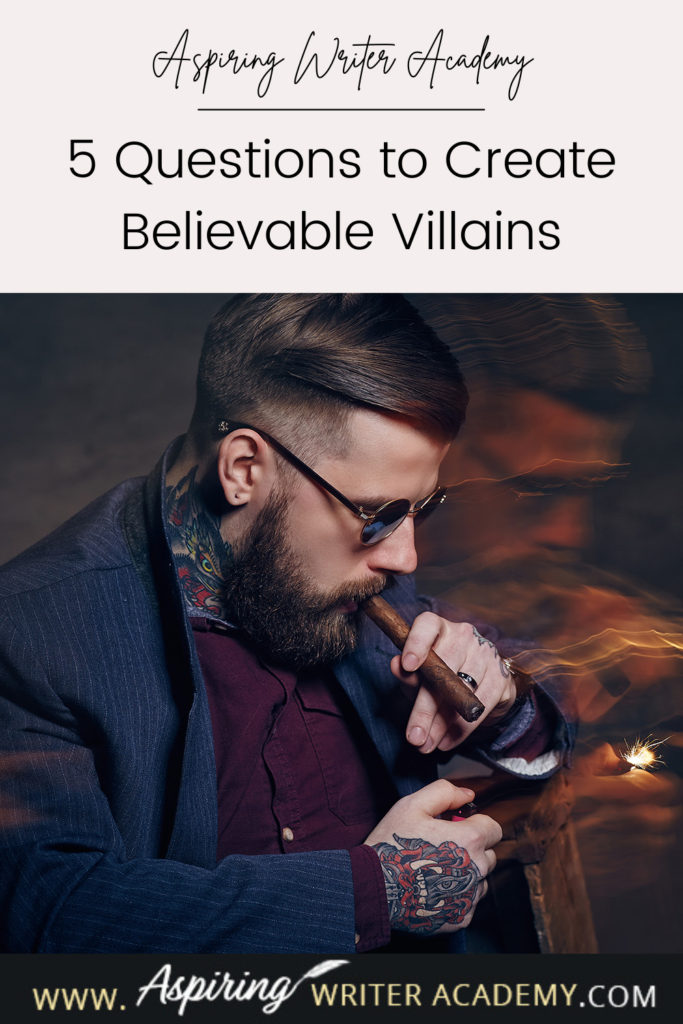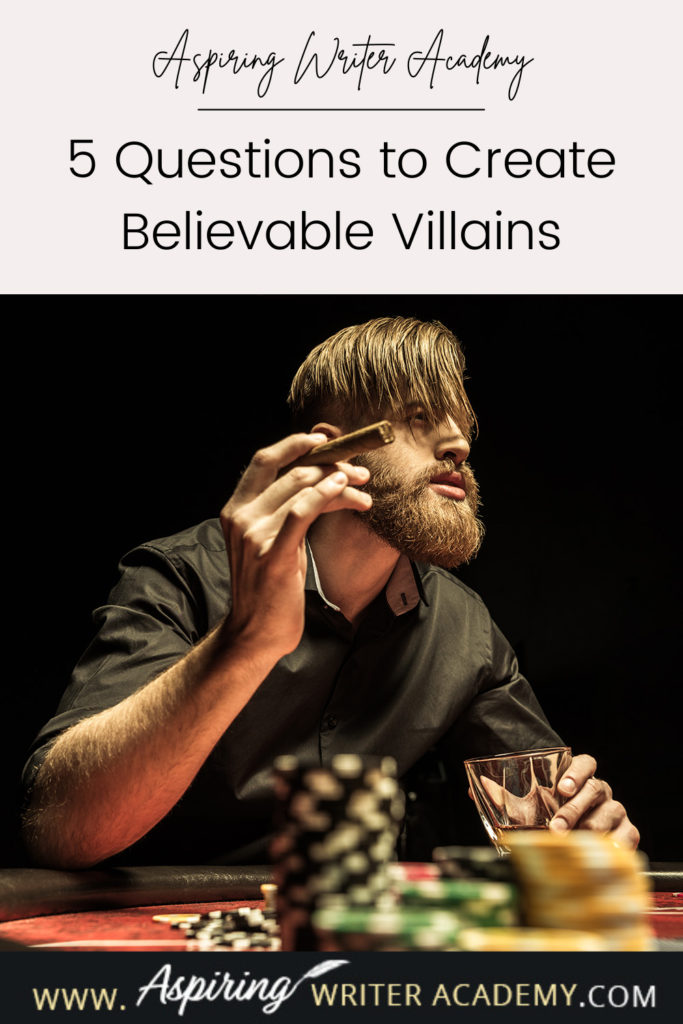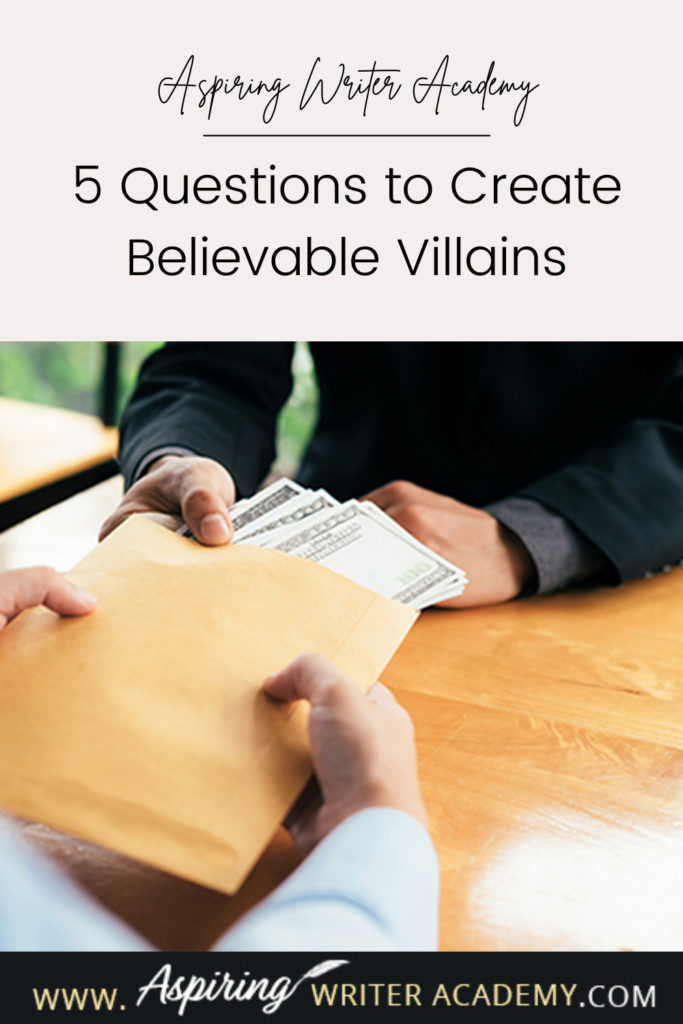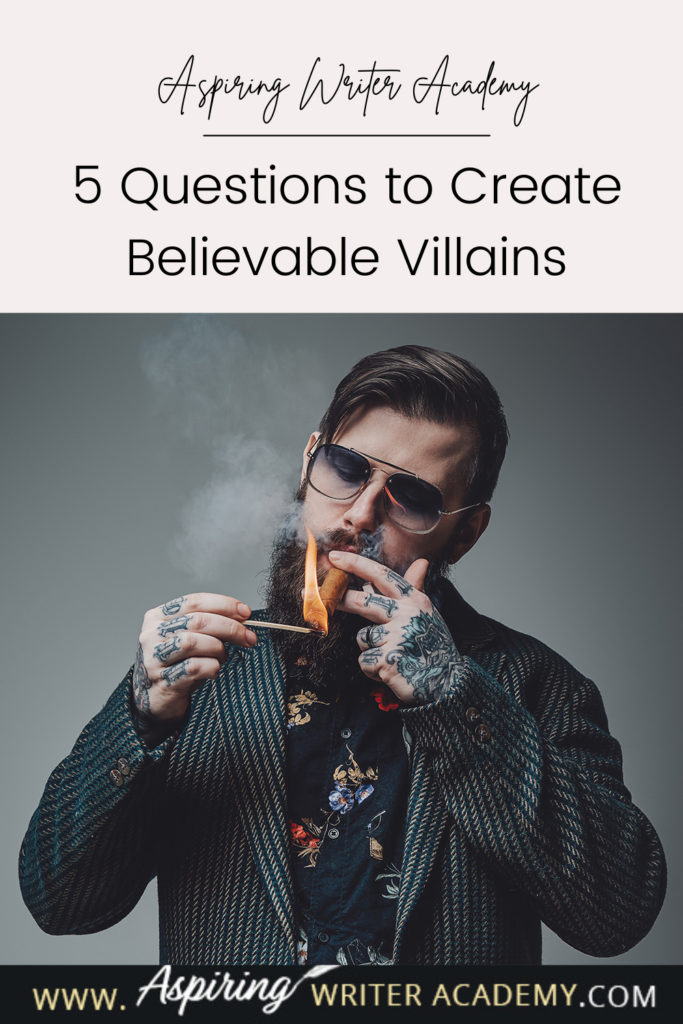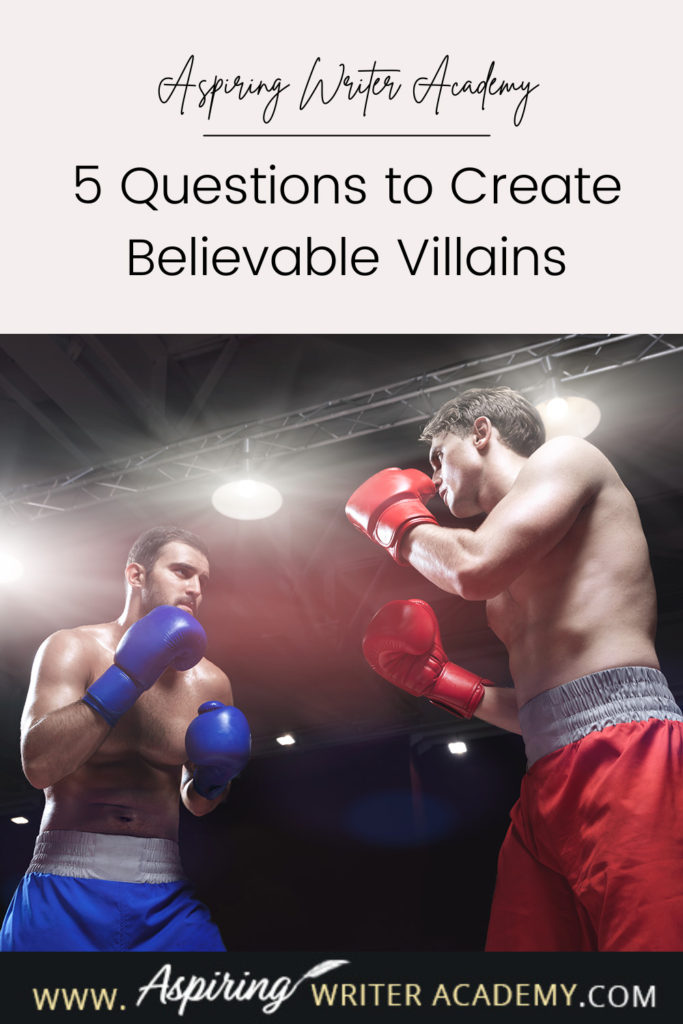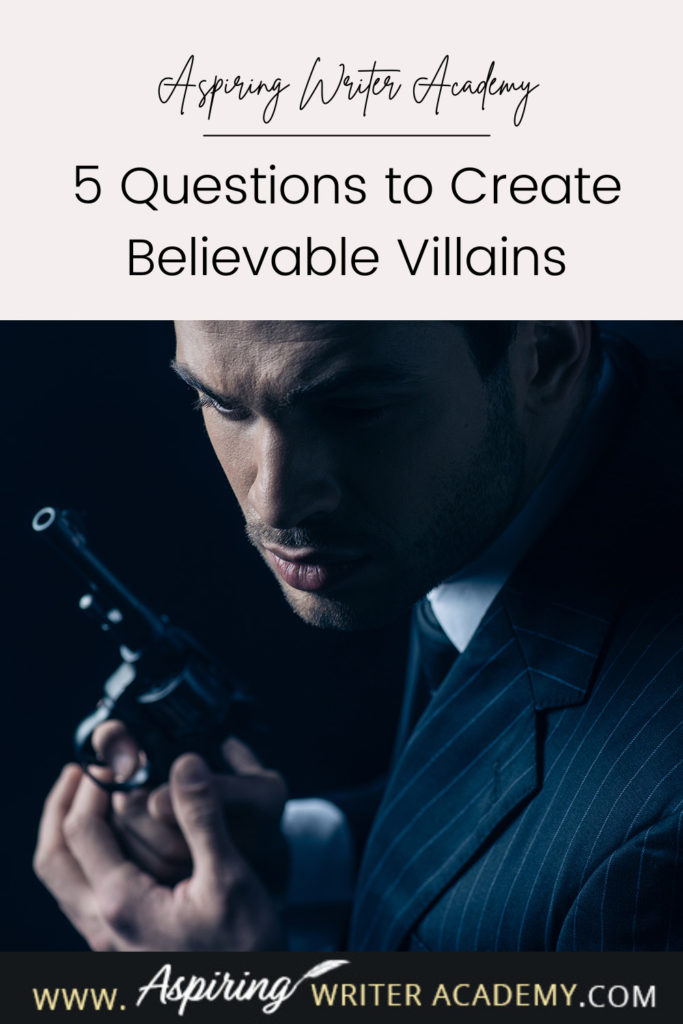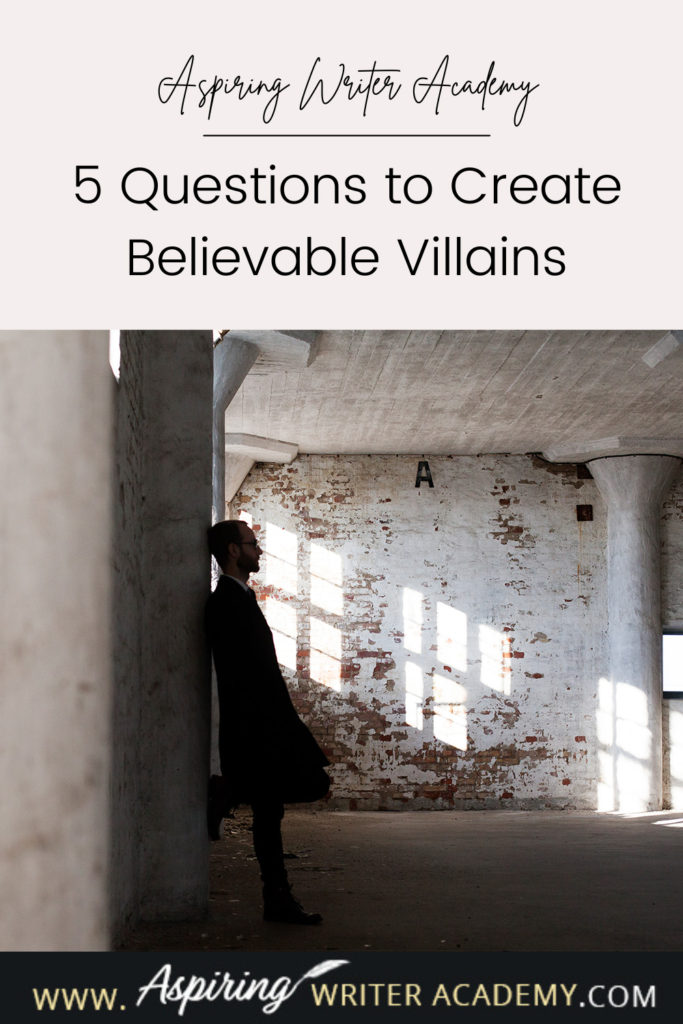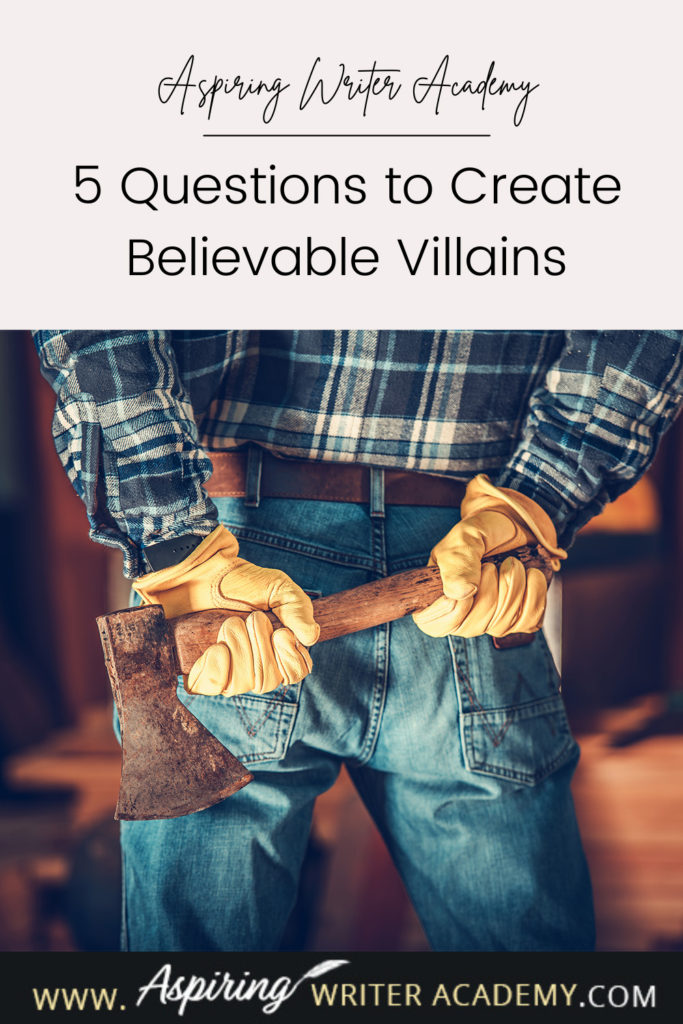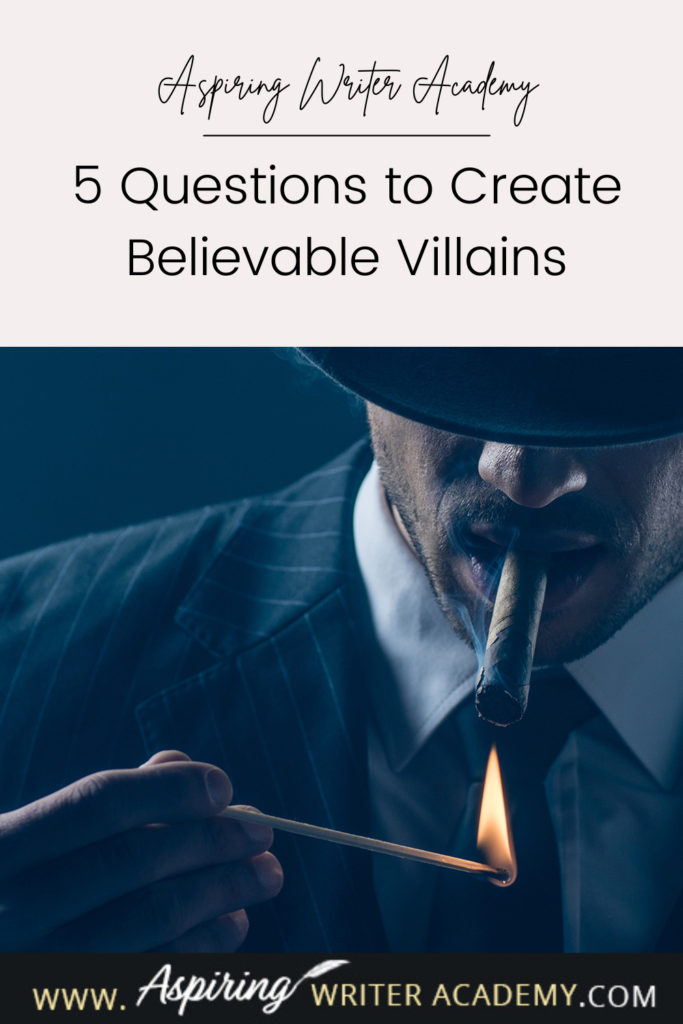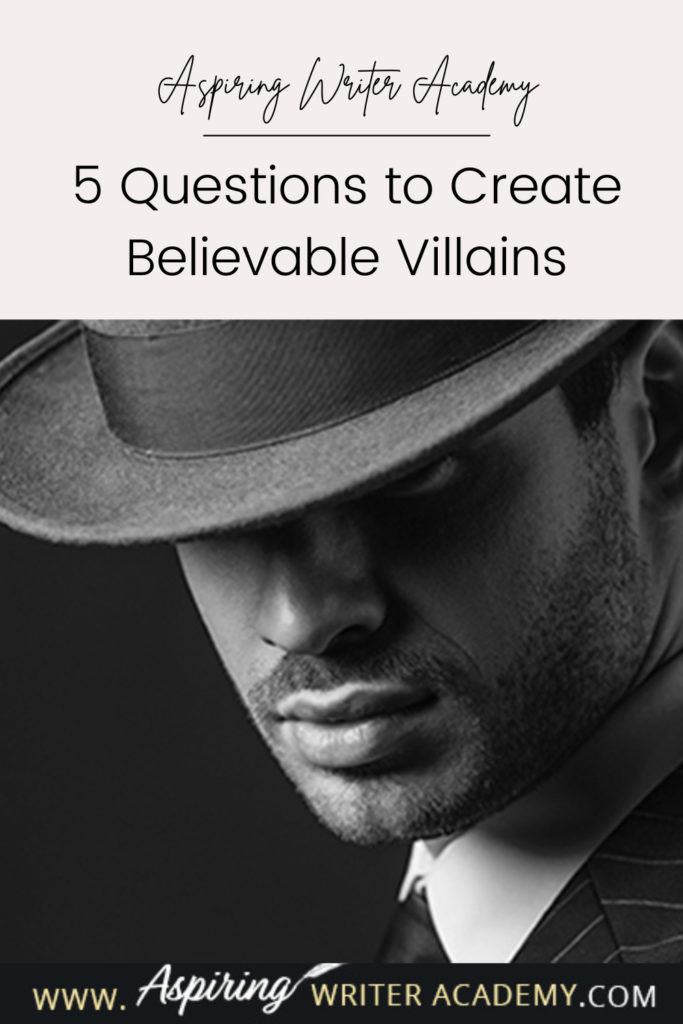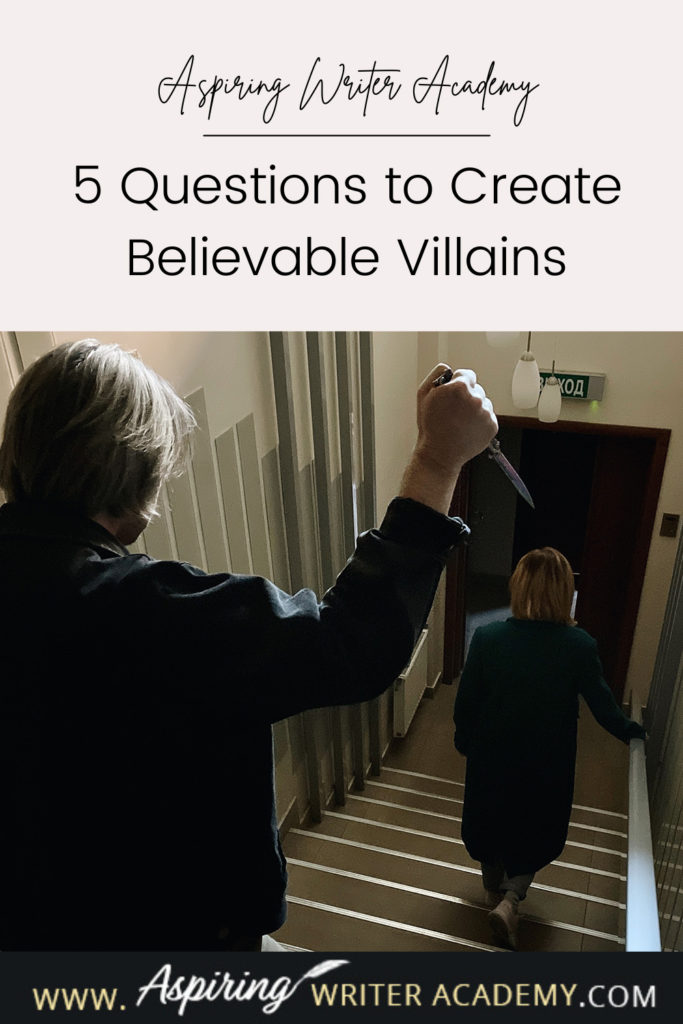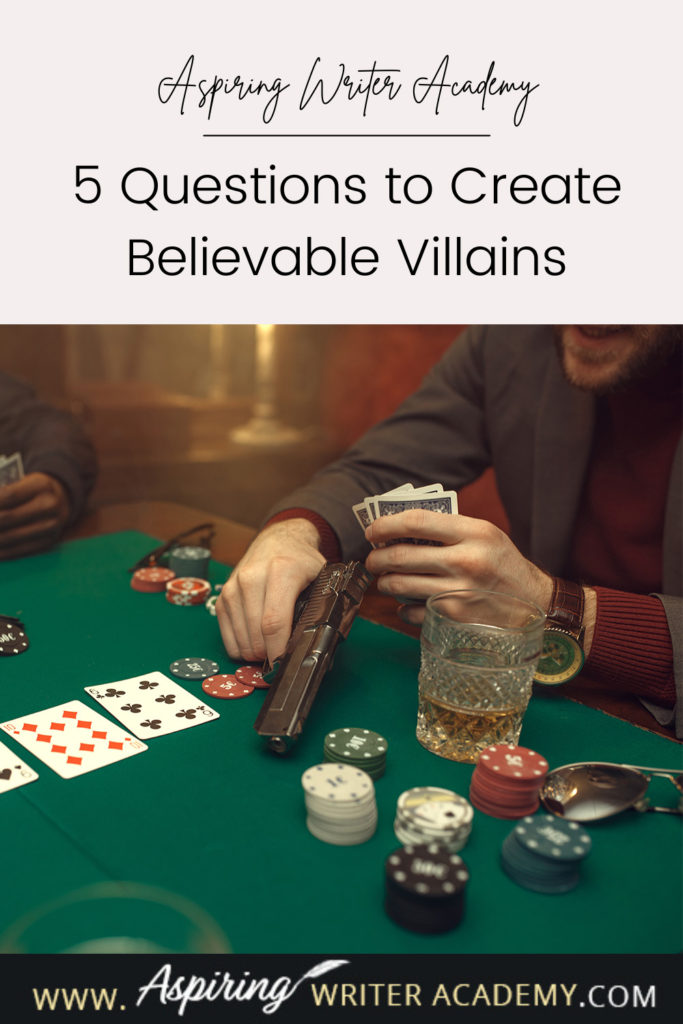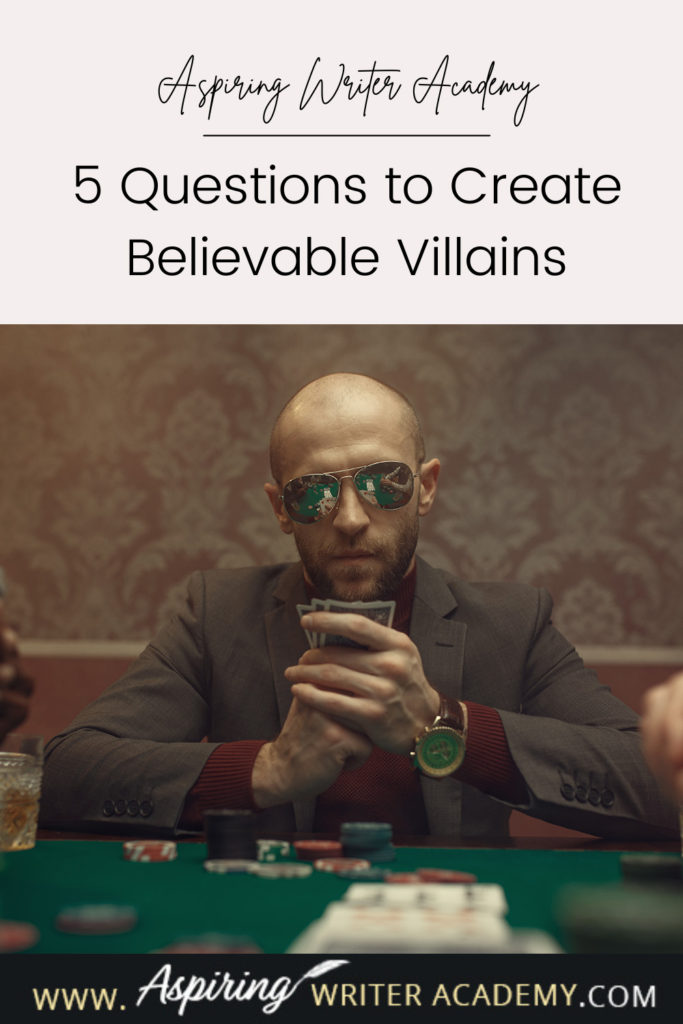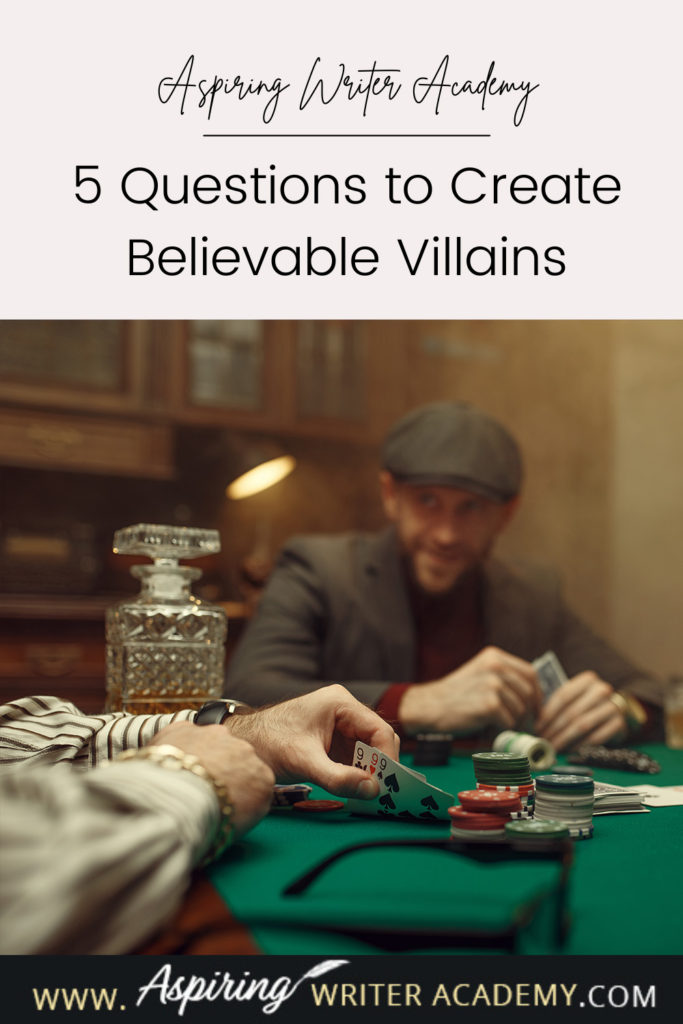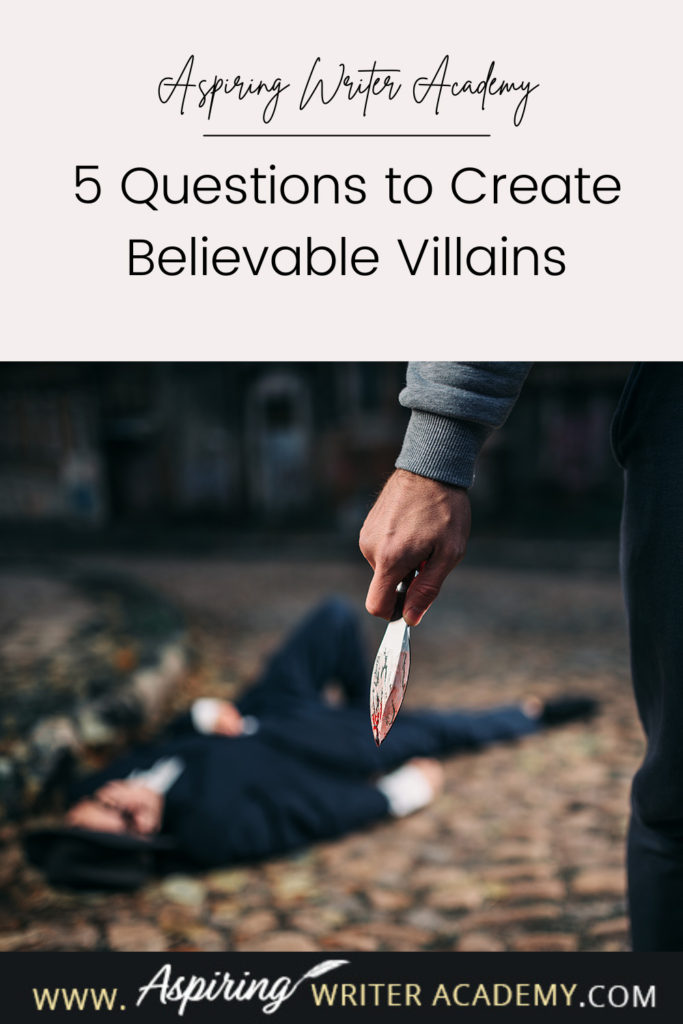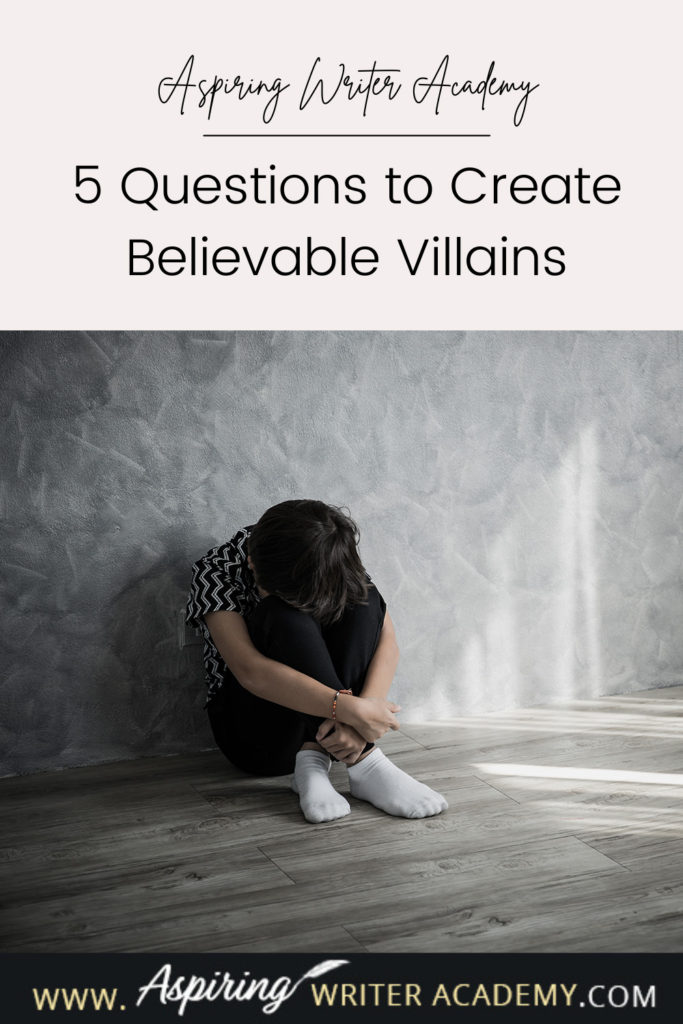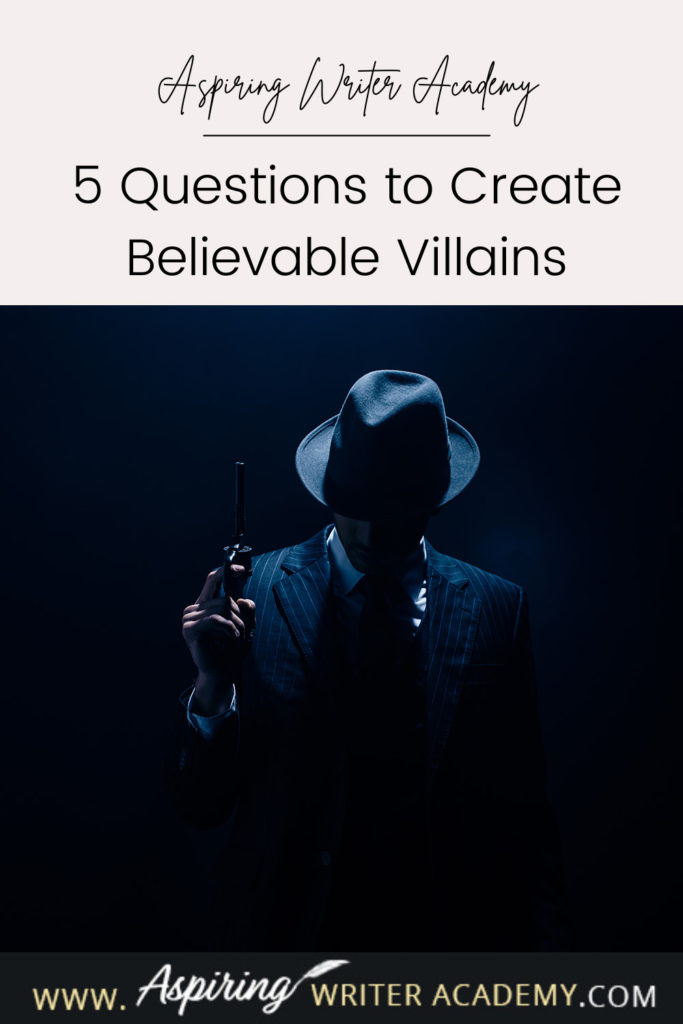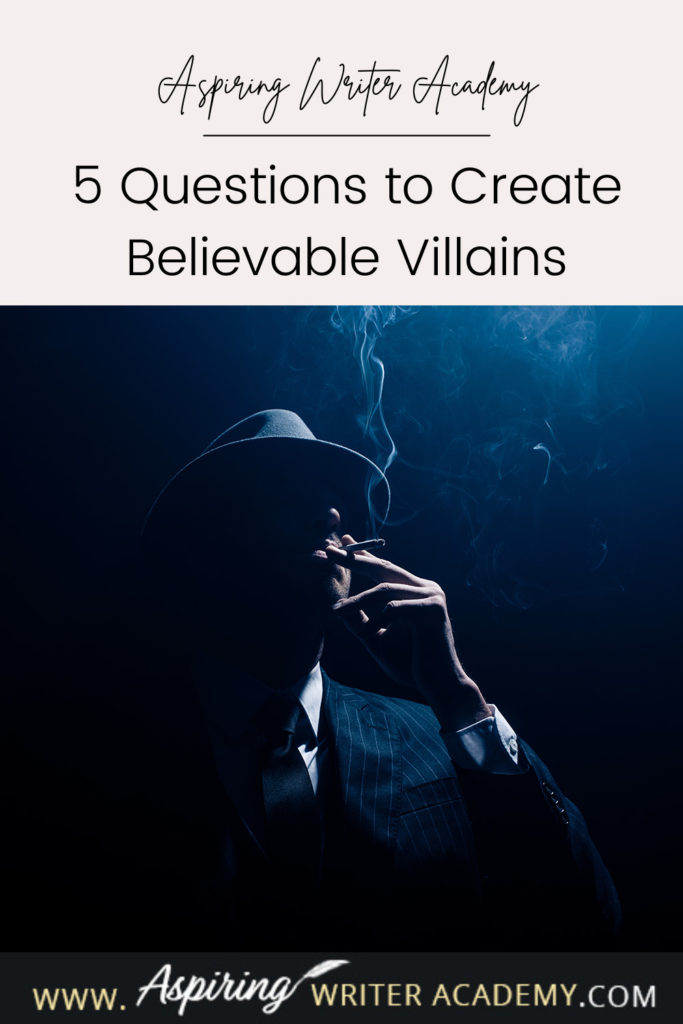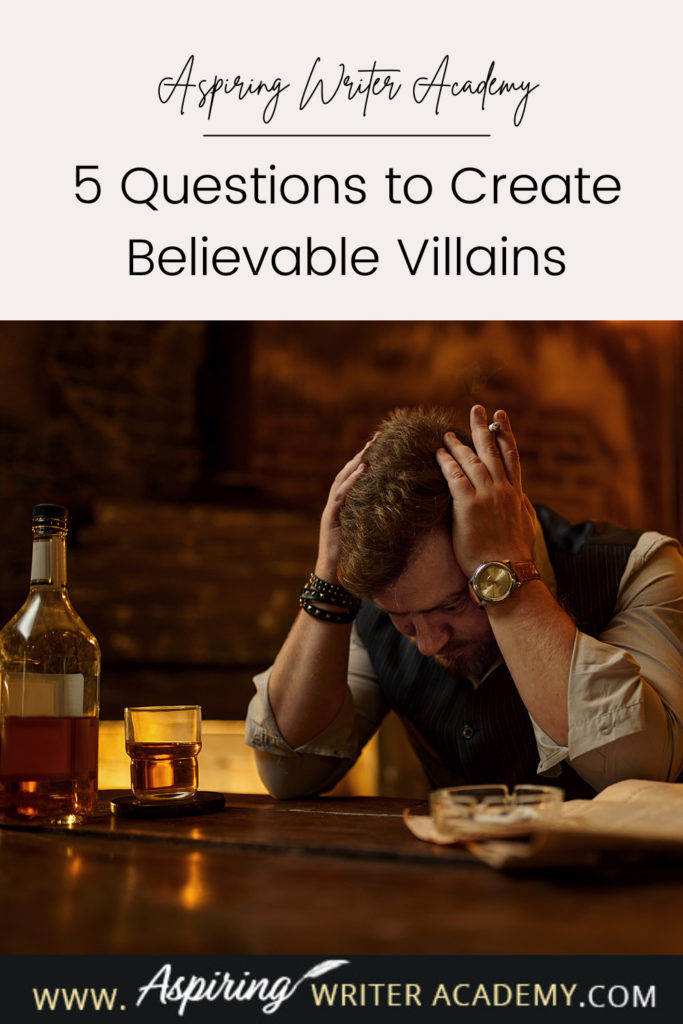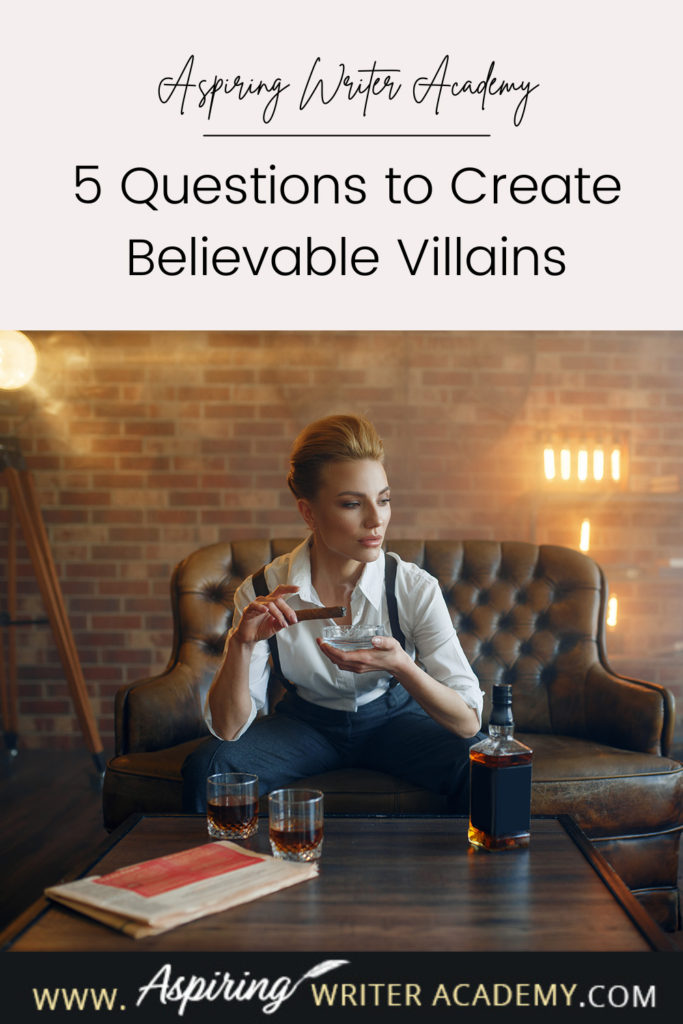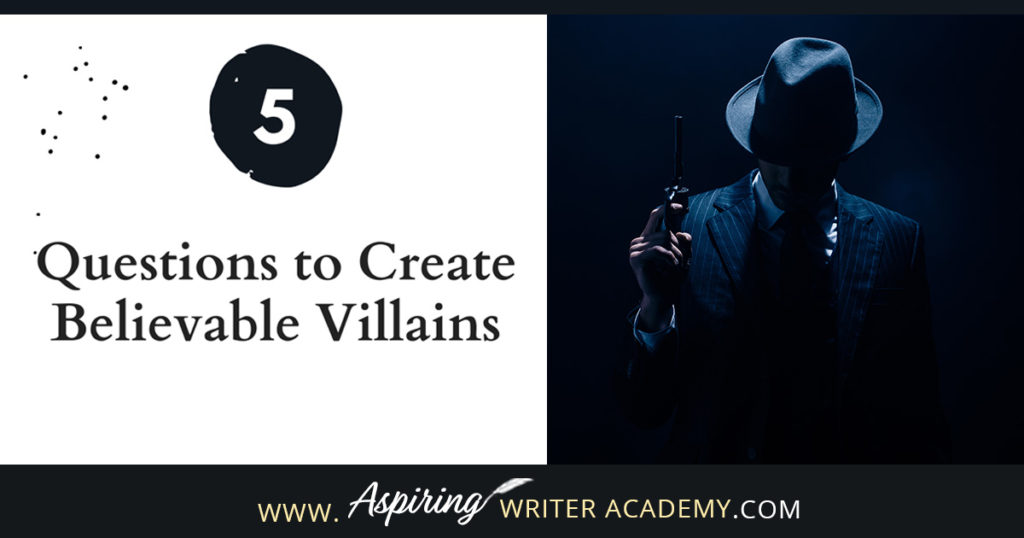5 Questions to Create Believable Villains
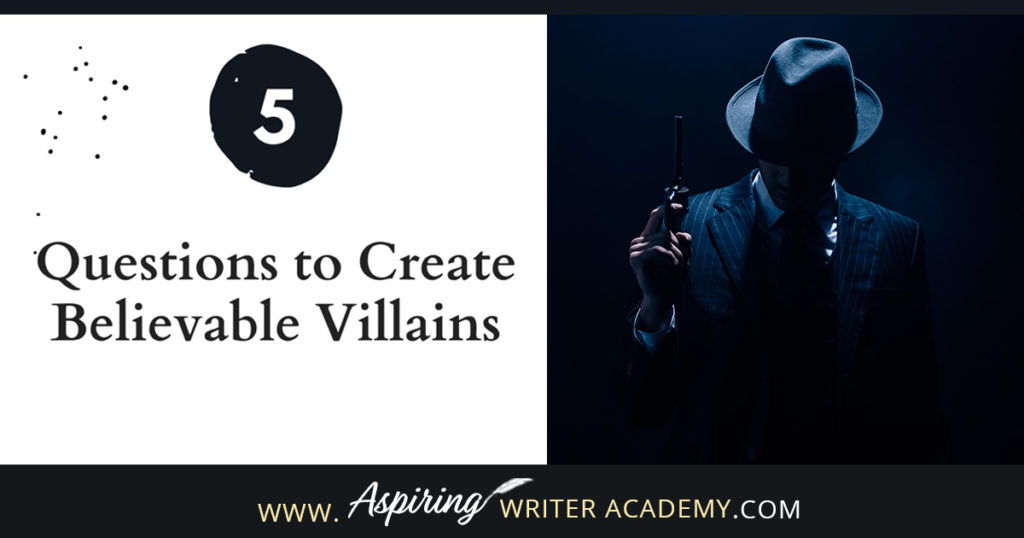
What is the difference between an antagonist and a villain? What motivates a villain to do heartless, hurtful, vindictive, terrible things? How can you bring the villain in your fictional story to life for your reader in an identifiable, believable, understandable way?
In our post, 5 Questions to Create Believable Villains, we explore the first questions you should ask when you start to brainstorm this type of character for your story.

Last summer, when the weather was still warm, my daughter and I were floating around the lake on tubes and brainstorming the suspense plot of a new story.
Suddenly we saw two other women staring at us and we remembered that water carries sound further than you realize.
If I overheard two people talking about the best way to murder a woman and hide her body and the murder weapon, and then frame another person to take the blame, I’d be suspicious too! LOL!
I smiled at the ladies, and they smiled back and laughed, so they must have realized we were harmless. Maybe they even suspected we were writers.
But brainstorming that day led me to think about the questions we need to ask ourselves to create believable antagonists and villains.
More specifically, you have to look at the story from their point of view and ask 5 basic questions: Who? What? Why? When? and Where?
1) Who is the Antagonist/Villain?
Once you know who the main character (protagonist) of your story is and what it is he/she wants to do, you need to figure out who can directly oppose their goal. After all, if attaining the goal is too easy for the protagonist, you won’t have a story.
What your story needs is CONFLICT.
(If you need help creating your protagonist, see: 10 Questions to Ask When Creating Characters for Your Story)
Your heroic main character, the protagonist, needs to change and grow as he pursues his goal, and it is conflict that helps him to do this. Conflict can come from a variety of sources, but today we are going to talk about the conflict that comes from other people.
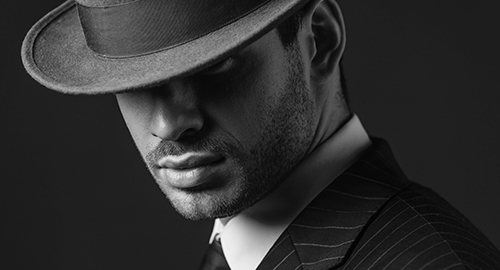
What is the difference between an antagonist and a villain?
A person who directly opposes the main character’s goal and causes him the most trouble is called the ANTAGONIST. There may be more than one in a story, but it is important to remember that an antagonist does not have to be an evil villain or even a bad guy. You may have two people with opposing views who each have a valid reason for believing what they do. Maybe they are just fighting over the same thing, like two dogs over a bone. It doesn’t necessarily mean either one of them are wrong, but they cause conflict for each other.
Then there are antagonists who are VILLAINS. This kind of person wants to stop the heroic main character from achieving his goals at any cost. He may intentionally cause harm to your protagonist throughout the story and nefariously devises ways to get what he wants.
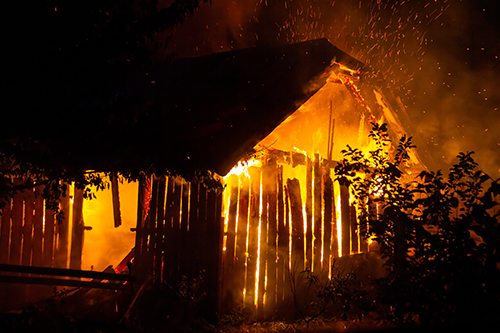
How can you make the villain more sympathetic, 3-dimensional, or believable for the reader?
A villain should have more negative traits than positive ones. However, your villain shouldn’t just be pure evil. You need to give him at least one trait the reader can identify with to make the character believable. He can have 3 negative traits and 1 good trait.
Example: You can have a villain who is a murderer, socially awkward, and doesn't take baths. But on the positive side, this villain also has a kid who he will protect at any cost.
Even if his intentions are wrong, the reader also must be able to understand why this villain thinks and acts the way he does. We need to know his motivation, his why. This is how you can keep your villain 3 - dimensional and interesting, instead of what editors call a shallow “cardboard villain” who is pure evil for no valid reason.

How can you make your antagonist or villain different, so he isn’t predictable or like other villains?
Example: In the movie, The Dark Knight (2008), the character Harvey Dent flips a coin to see whether his victims should live or die leaving their fate to chance. Flipping the coin makes this villain different than most and is not expected. This makes him more interesting.
Remember too, that the scariest villains don’t have to be dark or dirty with scars across their faces. Sometimes the scariest villains of all are the successful, clean-cut, next-door-neighbor types who the protagonist never suspected. Someone who’s been hiding in plain sight.
2) What does your antagonist want? What is his goal? What does he plan to do to attack/thwart the protagonist’s goal? What weapons will he use?
The antagonistic villain must also have a goal as strong as the main character’s if he is to be a worthy foe. This means the villain must have compelling motivation or valid reasons for opposing the main character, and he will have a specific plan of action to thwart the main character’s attempts to overcome the problem each step of the way.
The villain will play an active role in the story. He won’t just initiate one attack against the protagonist but will continue to cause him trouble throughout the entire story. The villain will try to stop the main character’s moves with countermoves of his own.
Villains must also have a strength equal or greater to that of the protagonist to make the battle between them more intense. In an action story or thriller, the villain may have a larger army or more money at his disposal to hire minions, perhaps an advanced skill like karate, archery, or sword fighting.

In a quieter story the villain may have a lethal tongue and be an eloquent speaker that sways others to do his bidding or he may have a rank that holds power. He may use his intelligence to outsmart others, or perhaps he is a pickpocket or knows how to cheat at cards or lie with a straight face. These are all weapons if the villain knows how to use them to his advantage.
Just be sure it is believable the villain has these strengths by showing or foreshadowing them early in the story before he uses them against the protagonist unless you want the reader and the protagonist to be surprised. In the latter case, you would follow this scene up with a segment that explains how the villain acquired this skill.
3) Why does the villain have it in for the other guy? Why does he want to oppose the protagonist? What happened in the villain’s past to make him think and feel and act this way? Why does he think he can get away with it?
Everything that happens in your story must be motivated or it is not believable. Without proper motivation the story does not make sense to the reader as things seem to happen randomly like a baseball flying at you from out of nowhere.
Where did it come from?
Let’s look at backstory. Somewhere in the villain’s past, maybe even in his childhood, there must have been something that happened that hurt him, or struck a chord with him, or made a distinct impression that helped him form a belief about who he is, what he must do to get ahead in this world, and why it is okay for him to do it.

His belief system may be wrong, but it explains why your villain operates on a daily basis the way he does. His warped beliefs are what drive him. They personify who he is as a person.
- Did his father walk out on him as a boy and tell him the only way he’d ever get ahead is if he learned to cheat?
- Did he admire his uncle for being a bully because no one could ever prevail against him?
- Did your villain have the wrong role models?
- Was he hurt and vows revenge? What happened in his past to make him feel justified taking revenge against others?
- Why does the villain feel that it is his right to try to take away what the protagonist wants?
- Why does the villain think that he deserves to win? What are the stakes? The antagonist must also have a lot to lose if he does not win. The stakes must be high for each side.

4) When does the villain plan to carry out his attack or misdeeds against the protagonist?
The story opens with your main character, the protagonist, living in their ordinary world, and he/she may be dealing with a small problem or pursuing a personal goal when all of the sudden, (usually in the 2nd or 3rd chapter of a book) an antagonist/villain appears and does something to turn your main character’s world upside down.
This is where the villain launches his first attack.
It appears the villain has the upper hand at this moment, but he will not sit back and watch what the protagonist does. He will remain active throughout the story every step of the way creating intense opposition to the protagonist and those who support the protagonist.
The villain may find he has to take greater risks, deadlier action, as the story unfolds to stop the protagonist from reaching his goals. After all, the villain wants to be the hero of his own story – the villain wants to win. He does not want the protagonist to make progress or learn new skills or take control. The villain may have to learn some new skills of his own to keep his level of power.
Toward the end of the story, at the climax, the villain will confront the protagonist in a face-to-face battle or stand-off, where only one of them will win. They will use everything they’ve got against each other at this point. It is a do or die moment and only one will be victorious.

Will your villain win or lose? Will he change at the end or have to work with the protagonist to defeat an even larger foe? How will this affect his way of thinking? His motivation? Who will your villain be at the end? Is it because he could NOT change or learn or grow that the protagonist defeated him? Did the villain deserve what was coming to him in the end?
How can you set this up or foreshadow this earlier in the story to make this ending and the villain’s actions or change believable?
The reader needs to know how and why this ending was possible.
5) Where does the villain hide out? Where does he plan to launch his attack? Why did he choose this setting? How does the villain find out where the protagonist is going to be?
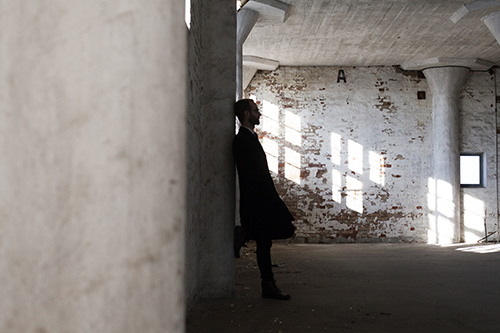
At the climax, toward the end of the story, does the villain face off with the protagonist at the same location as they did toward the beginning of the story during the Inciting Incident when the villain launched his first attack? How is the setting different than the first time they met?
Whatever the reason, make it mean something. Perhaps the characters have changed. Or the place has changed due to events during the story. Did the villain purposefully choose this location for a reason?
We hope that you have enjoyed reading 5 Questions to Create Believable Villains and that it helps you create highly motivated, unique villains that are more credible to your readers.
If you would like more help brainstorming characters or your story idea, you can download our Free Brainstorming Your Story Idea Worksheet with more examples and templates.
Do you find it difficult to create compelling antagonists and villains for your stories? Do your villains feel cartoonish and unbelievable? Do they lack motivation or a specific game plan? Discover the secrets to crafting villains that will stick with your readers long after they finish your story, with our How to Create Antagonists & Villains Workbook.
This 32-page instructional workbook is packed with valuable fill-in-the-blank templates and practical advice to help you create memorable and effective antagonists and villains. Whether you're a seasoned writer or just starting out, this workbook will take your writing to the next level.
If you have any questions or would like to leave a comment below, we would love to hear from you!
Our Goal for Aspiring Writer Academy is to help people learn how to write quality fiction, teach them to publish and promote their work, and to give them the necessary tools to pursue a writing career.

ENTER YOUR EMAIL BELOW
TO GET YOUR FREE
"Brainstorming Your Story Idea Worksheet"
7 easy fill-in-the-blank pages,
+ 2 bonus pages filled with additional story examples.
A valuable tool to develop story plots again and again.
Other Blog Posts You May Like
Why Your Characters Need Story-Worthy Goals
3 Levels of Goal Setting for Fiction Writers
Fiction Writing: How to Write a Back Cover Blurb that Sells
Fiction Writing: How to Name Your Cast of Characters
How to Captivate Your Readers with Scene-Ending Hooks
Scene & Sequel: The Secret to Plotting an Epic Novel
Scene & Sequel: The Secret to Plotting an Epic Novel (Part 2)
Writing Fiction: How to Develop Your Story Premise
12 Quick Tips to Write Dazzling Dialogue
10 Questions to Ask When Creating Characters for Your Story
Macro Edits: Looking at Your Story as a Whole
Basic Story Structure: How to Plot in 6 Steps

is a multi-published author, speaker, and writing coach. She writes sweet contemporary, inspirational, and historical romance and loves teaching aspiring writers how to write quality fiction. Read her inspiring story of how she published her first book and launched a successful writing career.


